Roses are perhaps the most well known of all garden plants, having a long history of use in landscaping and the medicinal arts.
Roses are perhaps the most well known of all garden plants, having a long history of use in landscaping and the medicinal arts. More recently though, Roses have enjoyed the intense focus of hybridisation and creation of a huge range of cultivars to satisfy our cravings for their ornamental qualities.
Today the keen and casual gardener has literally tens of thousands of rose variations to choose from, which can be quite daunting. So we attempt here to provide an easy guide to provide an overview of this fabulous genus of plants.
It's a huge subject overall, so we are breaking it down into three segments for ease of reading and research.
- History of the Rose and the Species Roses
- Old Garden Roses
- Modern Roses
We provide links at the end of each article to easily follow on to the next segment.
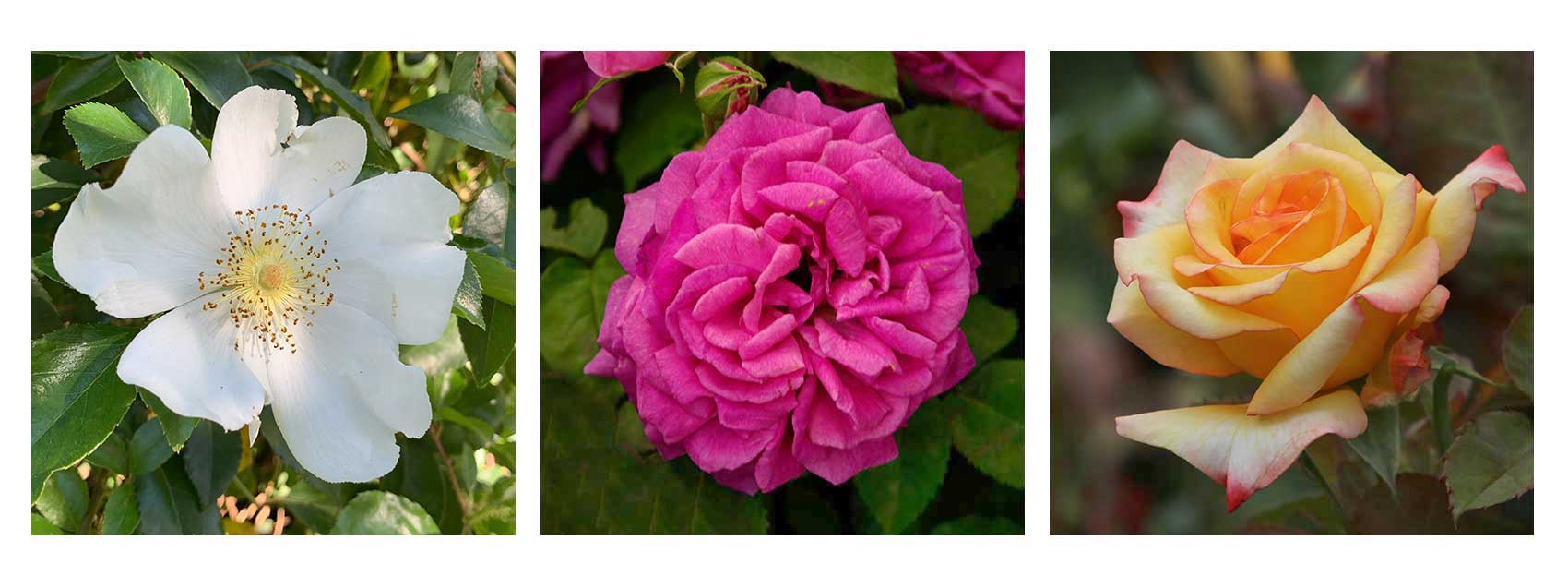 (L) Species - Rosa laevigata (C) Old-Garden - Rosa Bourbon (R) Modern - Rosa Hybrid Tea
(L) Species - Rosa laevigata (C) Old-Garden - Rosa Bourbon (R) Modern - Rosa Hybrid Tea History:
First came the wild roses (or species roses) which pre-date mankind, found in fossils to have existed as far back as 35 million years ago. They were first noted in cultivation in China 5,000 years ago and in the middle east at least 2,000 years ago.
These roses bear little resemblance to the sophisticated cultivars we see today, the originals tending to have rather unruly, scrambling forms while producing simple, five petaled, often fragrant, open faced flowers in early summer. These were all generally deciduous but hardy plants, being very resistant to pests and diseases. Almost all produce fruits after the flowers, known as rose hips, which contain the seeds and were soon recognised as having great health benefits, being very rich in vitamin C.
Some species roses are still cultivated today, though many naturally hybridised through cross-pollination on the wind or by birds and insects. These hybrids then naturally crossed with others and mankind eventually realised they could add their influence, the Chinese being the first to create roses that combined desired attributes. Some of these included repeat blooming, smaller and neater forms, new fragrances and deeper colour shades.
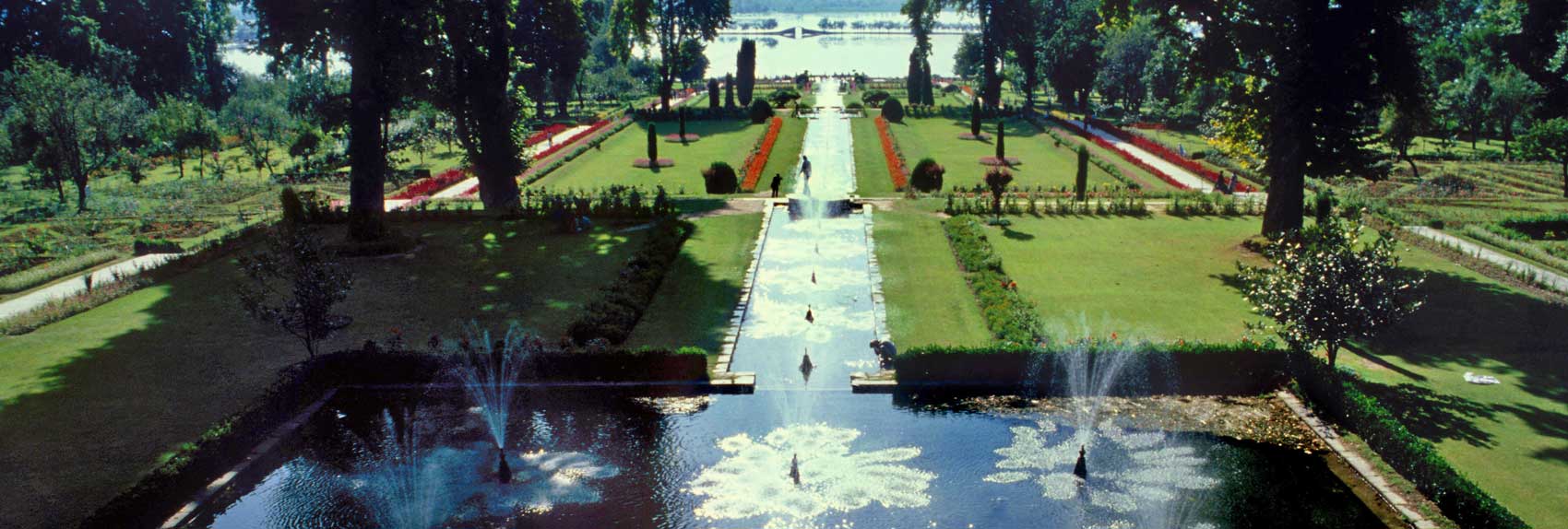 Persian style water gardens in Kashmir
Persian style water gardens in KashmirThe Persians used roses extensively in their formal gardens alongside cool watercourses and fountains, while the Romans used roses as fragrant confetti and for medicinal purposes. The Syrians and Persians found that the flowers could be soaked or steamed to release their oils and the resultant rose water became highly prized as a perfume and as an ingredient in cooking, especially sweets like Turkish Delight and jams.
The Mediterranean played a large part in the spread of the rose with the Romans, Greeks and Phoenicians not only cultivating roses, but trading them as well.
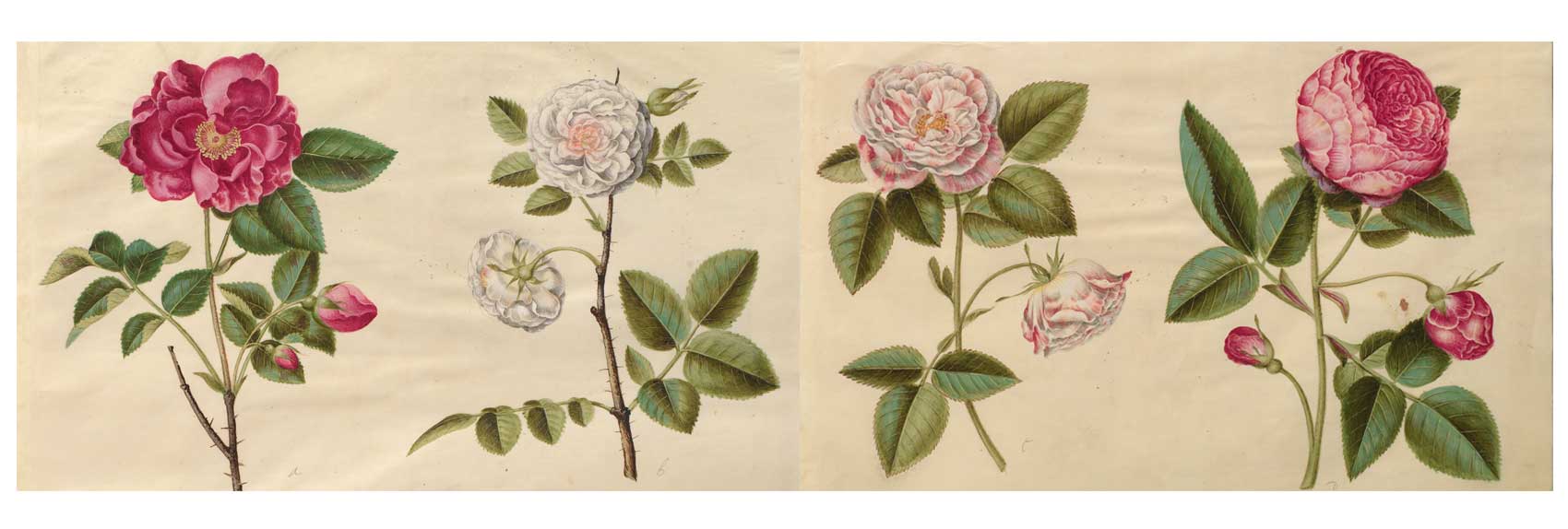 Throughout history the rose has intrigued and beguiled. Holtzbecher print of rosa Gallica.
Throughout history the rose has intrigued and beguiled. Holtzbecher print of rosa Gallica.In 300BC, around the time of Alexander the Great, a Greek scientist and writer by the name of Theophrastus made the very first catalogue of Roses including detailed botanical descriptions. This combined with the ruler’s conquests and mercantile activities was probably the original and major cause of the spread of Rose Worship throughout the ancient western world.
As other Empires grew, especially the Roman, so the influence of the rose spread. Romans had developed a passion for roses with nobles cultivating their own private gardens and over 2,000 public rose gardens being created throughout the empire.
Whilst Roman legions may have brought slaughter and oppression across Western Europe, they also brought their dreams, which of course influenced and enriched locals.
But as the power of Rome waned, the luxuries of life disappeared as locals reverted back to the realities of self rule. It fell to the monasteries to maintain the few remaining rose gardens along with other medicinally orientated horticulture.

By the 12th century crusaders returning from the middle east brought a renewed interest (along with a few specimens) having seen so many exotic rose gardens on their travels.
Once again the rose was returning to favour and the early European nouveau-riche merchants were demonstrating their wealth by creating exotic flower gardens alongside their houses – a habit that burgeoned with time.
By the 18th century around 90 different species of rose were catalogued thanks to the revolutionary work of Carl Linnaeus, the father of modern taxonomy along with the addition of around 35 new species from North America which had played a significant part in the cultures of native Americans over millennia, who grew them for ornamental as well as medicinal purposes.
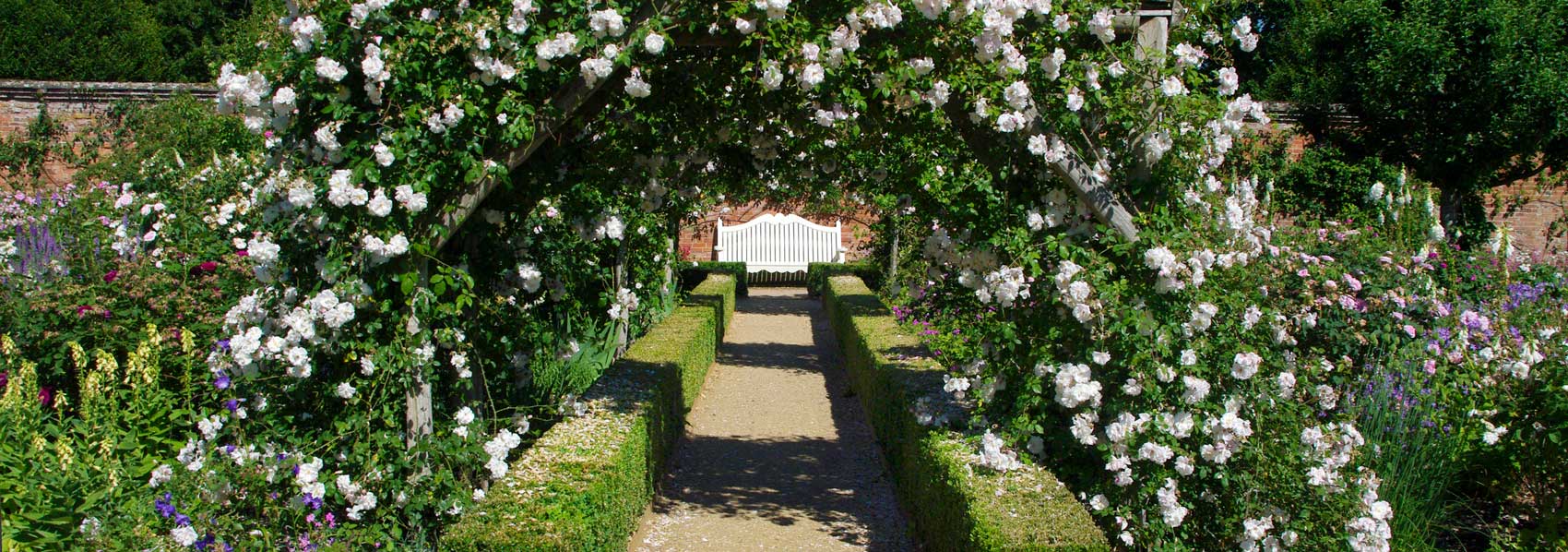 Mottisfont Abbey Rose Garden, Hampshire, UK
Mottisfont Abbey Rose Garden, Hampshire, UKToday it is recognised that there are around 120-150 original species roses and many are enjoying a renaissance today, mainly due to their unabashed simplicity and ability to withstand pests and diseases.
They are a rose for the purist, for the gardener who seeks simple beauty and is prepared to put up with some natural imperfections. To quote Monty Don
“If a hybrid rose like 'Fantin-Latour' is a silk ball gown, then species roses are a cotton frock. There is no further reduction to be had from them. There is no clumsy trace of the breeder's hand. If they tangle then that, dear gardener, is what they do. If they only flower for a few days, then that is as fixed as the weather. This imbues them with a freshness and wildness that I love.”
Here are a selection of the more well known Species Roses:-
• Rosa arvensis or the Field Rose is native to the British Isles and still seen in hedgerows of Southern England today. This is a vary fast growing rose with arching stems that produces lovely pure white, open faced flowers with prominent yellow stamen in mid summer.
It takes on a mounded shape and goes well in woodland style gardens, makes excellent hedges or can also be used as a specimen shrub in larger gardens. The flowers attract birds, bees, butterflies and insects while the hips attract wildlife for valuable food.
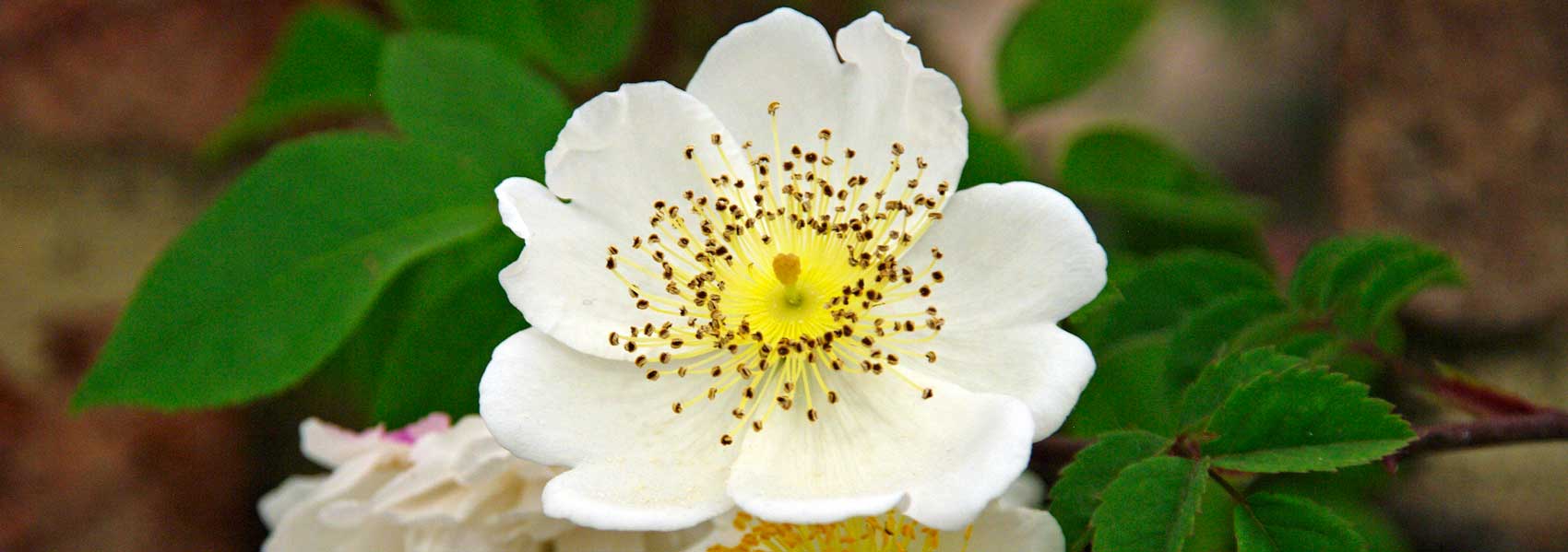 Rosa arvensis
Rosa arvensis• Rosa banksiae – an almost thornless scrambling rose from China that blooms with pretty white or yellow flowers once a year. It can cover vary large areas and is particularly suited as a pergola cover or supported against a warm brick wall.
Rosa banksia lutea (as illustrated here) is perhaps the most enchanting with its butter-yellow blooms and delicate fragrance.
 Rosa banksiae
Rosa banksiae• Rosa californica originates from Northern Mexico through to Oregon and is not surprisingly very hardy, tolerating drought well, though it does also thrive in moist soils near waterways.
It suckers and grows to around 2 metres in a wide range of conditions, producing lovely pink, open faced and fragrant blooms from long, pointed buds in early summer.
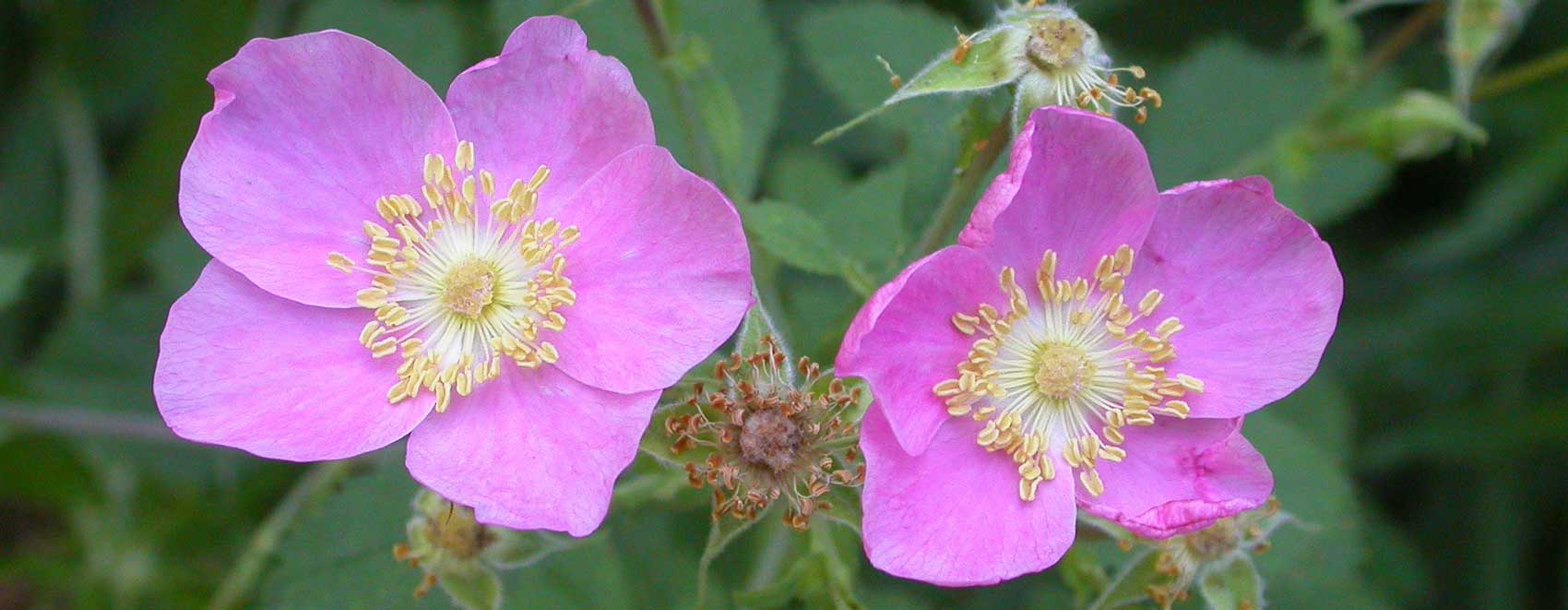 Rosa californica - photo Curtis Clark
Rosa californica - photo Curtis Clark• Rosa canina – or the dogrose originates from Europe and has very sharp, curving thorns which help it scramble or climb.
It has mid green foliage, pale pink or white, open faced, fragrant flowers in mid summer and can grow rapidly to a height of up to 3 metres. The pollen is favoured by bees and it is a good source for fragrant oils.
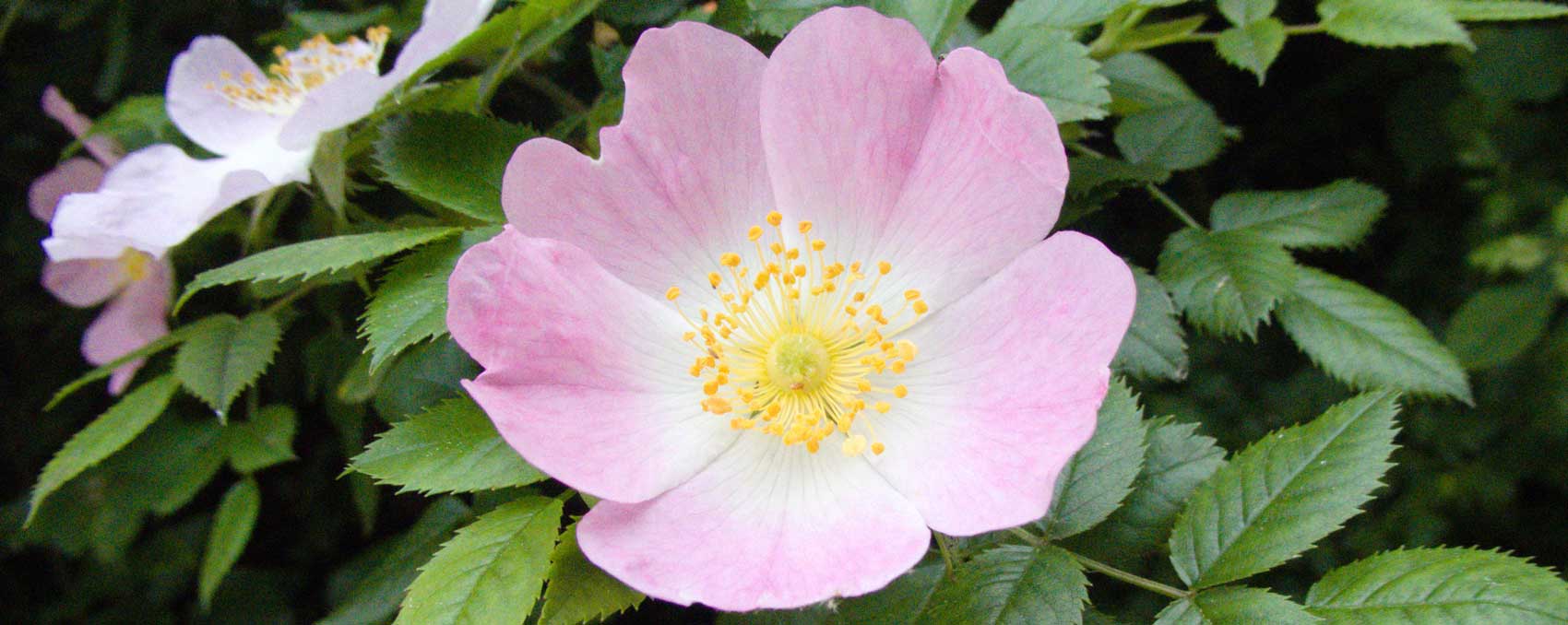 Rosa canina - photo Syrio
Rosa canina - photo Syrio• Rosa fedtschenkoana is named after Olga Fédchenko a Russian botanist and originates from Central Asia and Northern China. It grows to around 2.5 metres in height and features very prickly branches and pale greeny grey foliage.
Clusters of white flowers are produced throughout summer and are said to smell of brown bread and jam.
This is a very significant wild species rose being a parent of the Damask group of roses (along with R. moschata and R. gallica) and is renowned for bringing its repeat flowering characteristics (remontant) to modern roses.
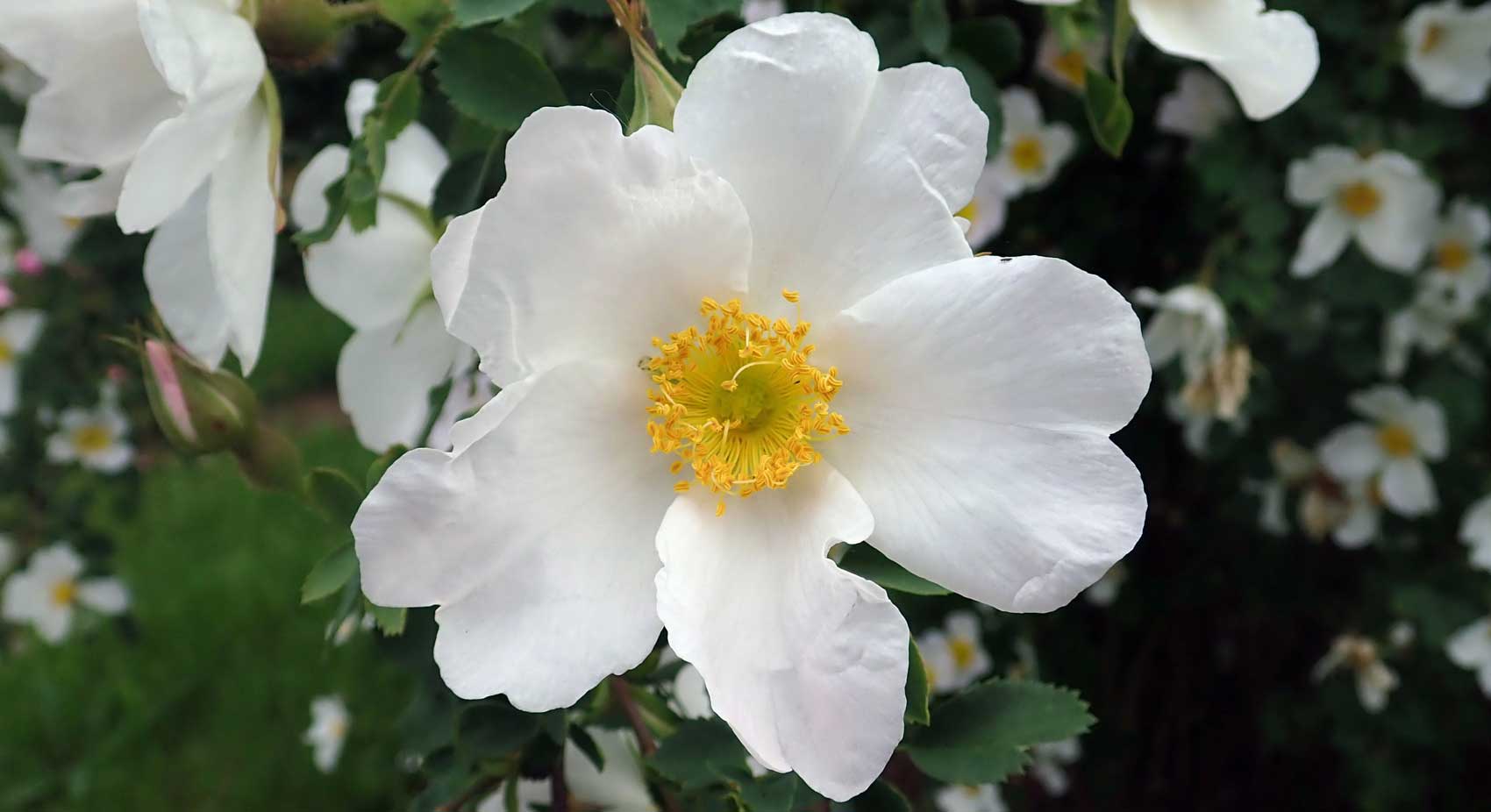 Rosa fedtschenkoana - photo Salicyna
Rosa fedtschenkoana - photo Salicyna• Rosa foetida or Austrian Briar originates from the Caucasus Mountains in Georgia and provides the parentage for all yellow roses. It was first imported into Europe from Persia in the 16th century and has a rather fetid aroma (hence the name).
This is a naturally tall rose, growing up to 2.4m with rather dull, greyish foliage but it makes up for it with the fabulously rich yellow, cup shaped blooms.
It can withstand colder climates but its one real weakness is its susceptibility to blackspot, an attribute that it passed on to all cultivars that were bred from it.
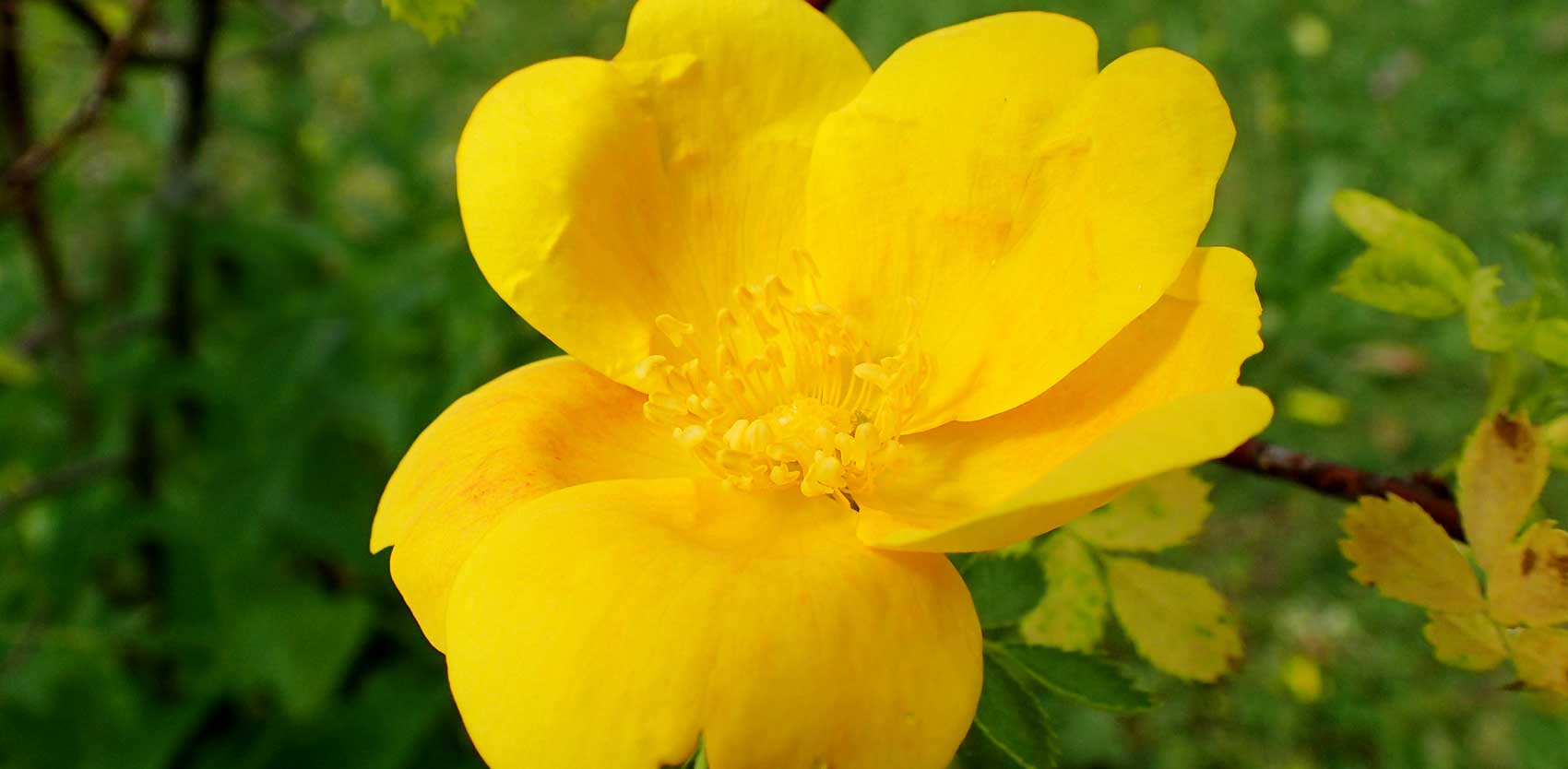 Rosa foetida - photo Krzysztof Ziarnek
Rosa foetida - photo Krzysztof Ziarnek• Rosa forrestiana or Forrest's Rose was discovered in Yunnan province of China in 1918. It is a vigorous shrub that grows to 2 metres in height and can handle very hard frosts, even as low as -20c. It has medium green leaves with serrated edges and simple, open faced flowers in shades of pink, gradating to white at the centre next to the golden stamens. Flowers have 4-8 petals and tend to be solitary 2-3.5cms in diameter or grow in small clusters.
These are single flush bloomers, making a colourful display in spring which mature to rather decorative, elongated, red hips. This remains a good species rose to grow in larger domestic gardens, especially to cover rocky slopes and due to its cold tolerance is an excellent choice for Alpine gardens.
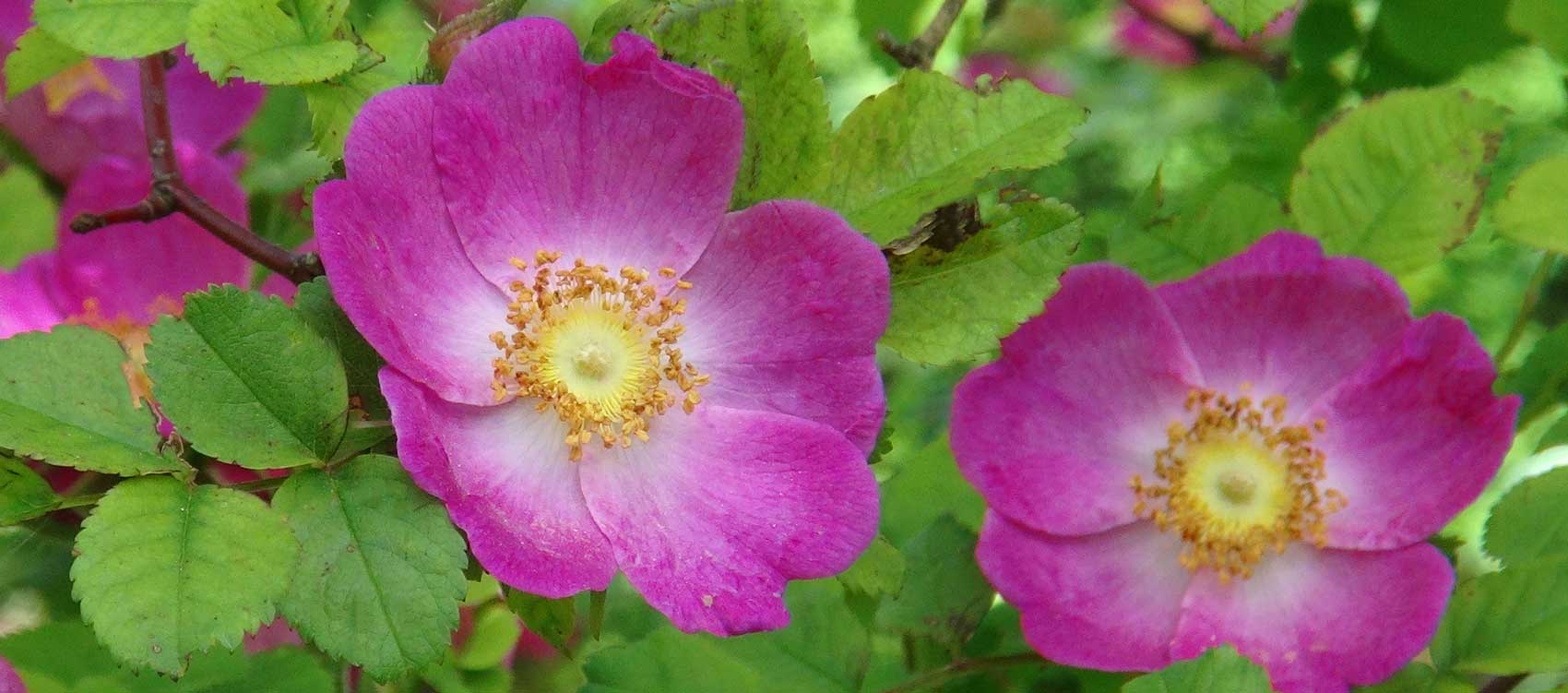 Rosa forrestiana
Rosa forrestiana• Rosa gallica or the French Rose originates from southern Europe with lovely, soft, sweetly scented deep pink flowers. It is one of the oldest species rose to be identified and appears to have grown all over central and southern Europe.
It was also one of the first roses to be cultivated by the Greeks and Romans and was very popular in mediaeval times.
Gallica roses are low growers, only around 30 cms high with a tendency to sucker. They produce a single flush of blooms and are still popular in cultivation, though many now have semi-double or double blooms and a tendency towards being bushier.
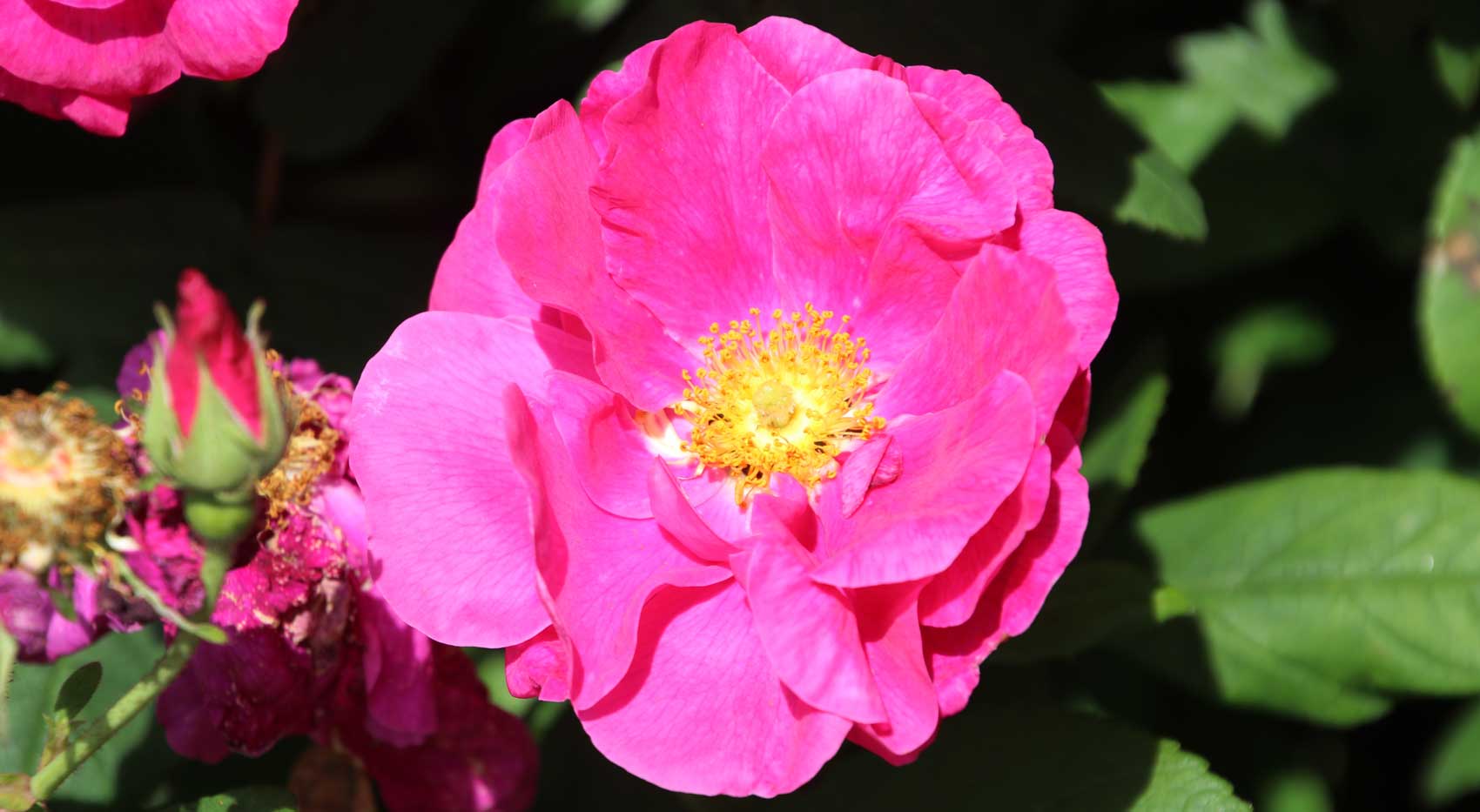 Rosa Gallica
Rosa Gallica• Rosa gigantea or the Wild Manipur Tea Rose originates from northern India, Myanmar and south west China and as its name suggests is the largest of all wild species roses. It can climb to 20 metres in height and produces very fragrant flowers up to 14 cms across that can be white, cream or yellow.
Although a wild species rose in its own right, it is also sometimes referred to as a variety of Rosa odorata (var. gigantea).
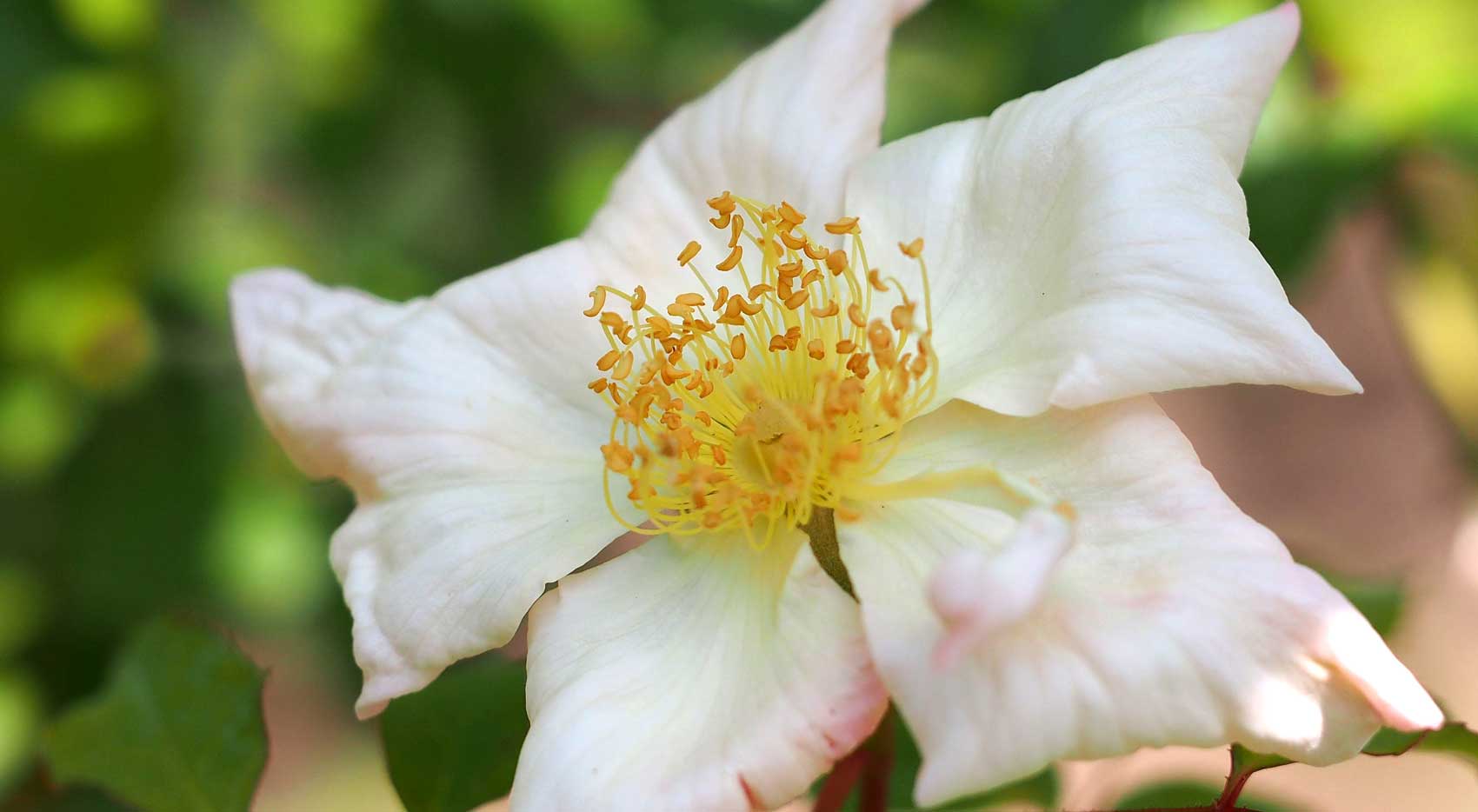 Rosa gigantea - photo T Kiya
Rosa gigantea - photo T Kiya• Rosa glauca (rosa rubrifolia) or the Redleaf Rose is one of the most cold hardy, with gracefully arching, almost thornless, reddish coloured stems.
The flowers appear in clusters and are simple, open faced, pink with white centres and prominent yellow stamen. The foliage is dusky, cinnamon coloured and this vigorous rose will easily fill an area of 2.5mx2.5m if you let it.
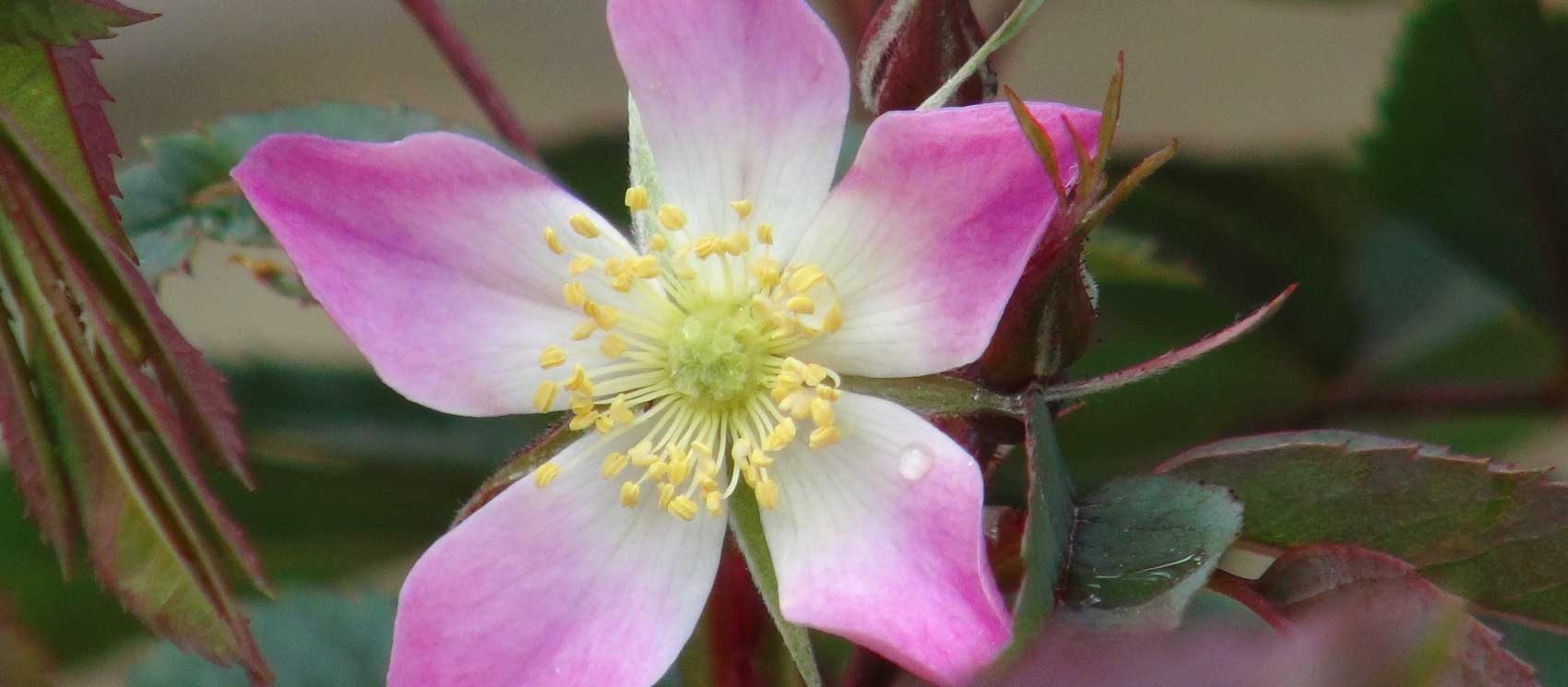 Rosa glauca
Rosa glauca• Rosa laevigata or the Cherokee Rose is one of the best for warm climates, growing extensively (and sometimes uncontrolled) in the southern states of the US. It is revered by the Cherokee Indians as a gift from the spirits, most likely due to the simple, fragrant white blooms that appear in late springtime.
Rosa laevigata originated from China, Taiwan and Vietnam and grows vigorously up to 6m, often scrambling over other plants. In warmer climates it remains evergreen and is very resistant to diseases. The pretty flowers are followed by handsome orange hips.
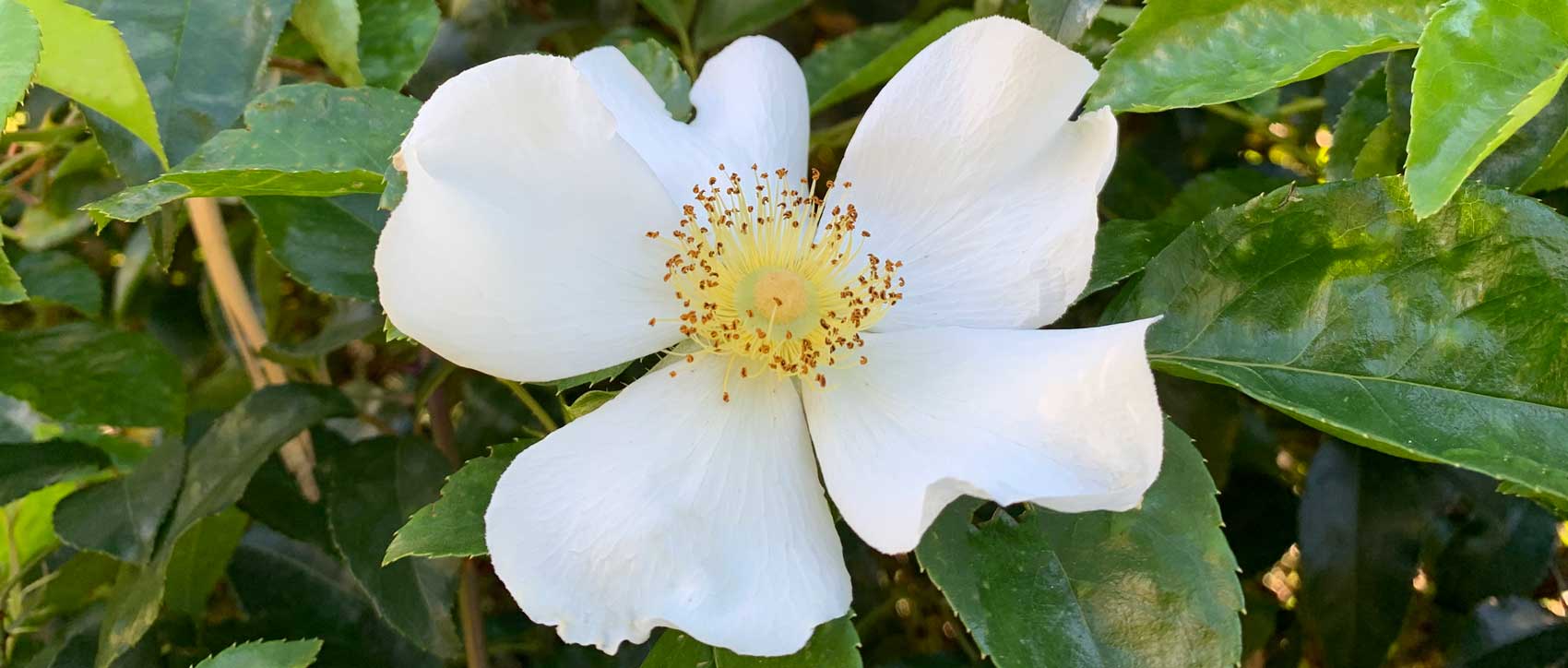 Rosa laevigata
Rosa laevigata• Rosa moschata or the Musk Rose originates from the Himalayas. It produces clusters (or corymbs) of fragrant, white flowers over long periods, sometimes into autumn.
This rose is particularly revered for its musky scent which comes from the stamen. The Musk Rose has been a major contributor to rose breeding, being a parent of the Damask Rose and the Noisette Group of roses.
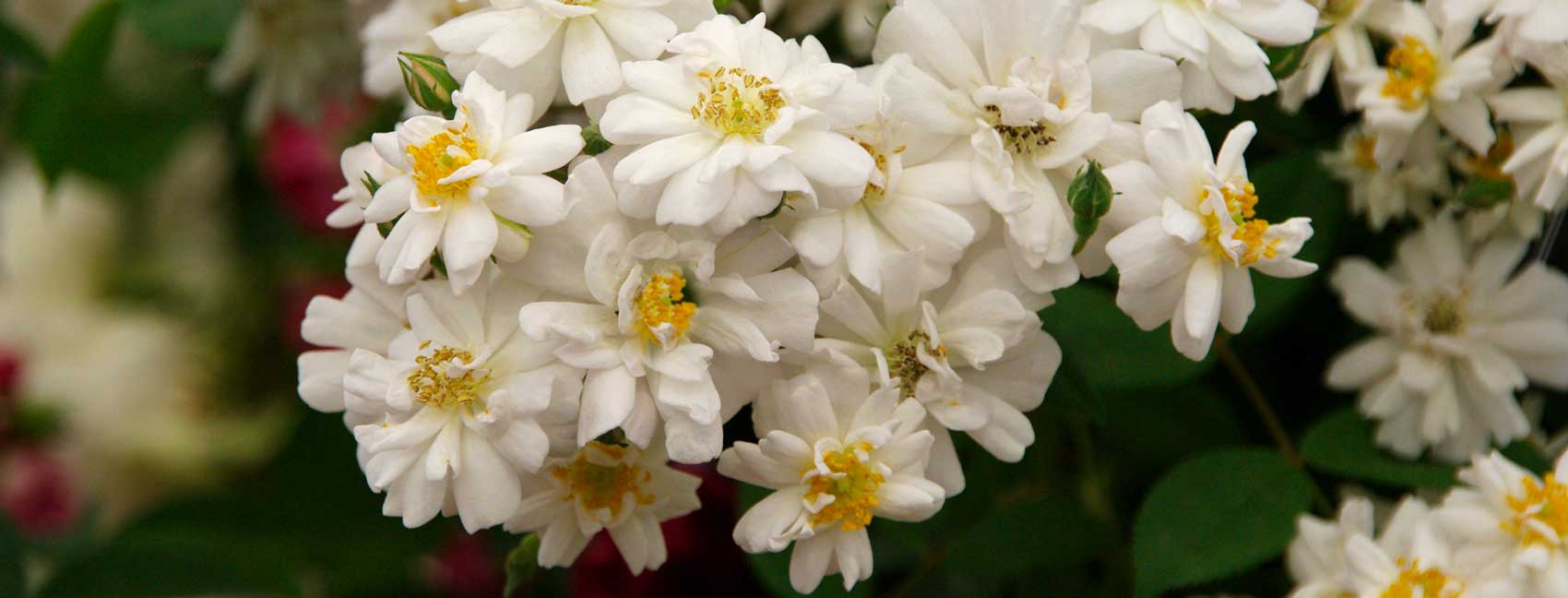 Rosa moschata ‘Garland’
Rosa moschata ‘Garland’• Rosa moyesii or Mandarin Rose or Moyes Rose comes from Western China and is very hardy, having a robust, arching habit and lustrous, dark green foliage which is then covered with large, wine-red and sometimes pink flowers in springtime and early summer.
A healthy specimen will be almost completely covered in blooms which are then followed by striking bottle-shaped, orange rose hips that provide extra garden interest and are an excellent source of vitamin C.
These are lovely and vigorous shrubs with an attractive, upright, rounded habit which goes well in borders or can make a superb informal hedge.
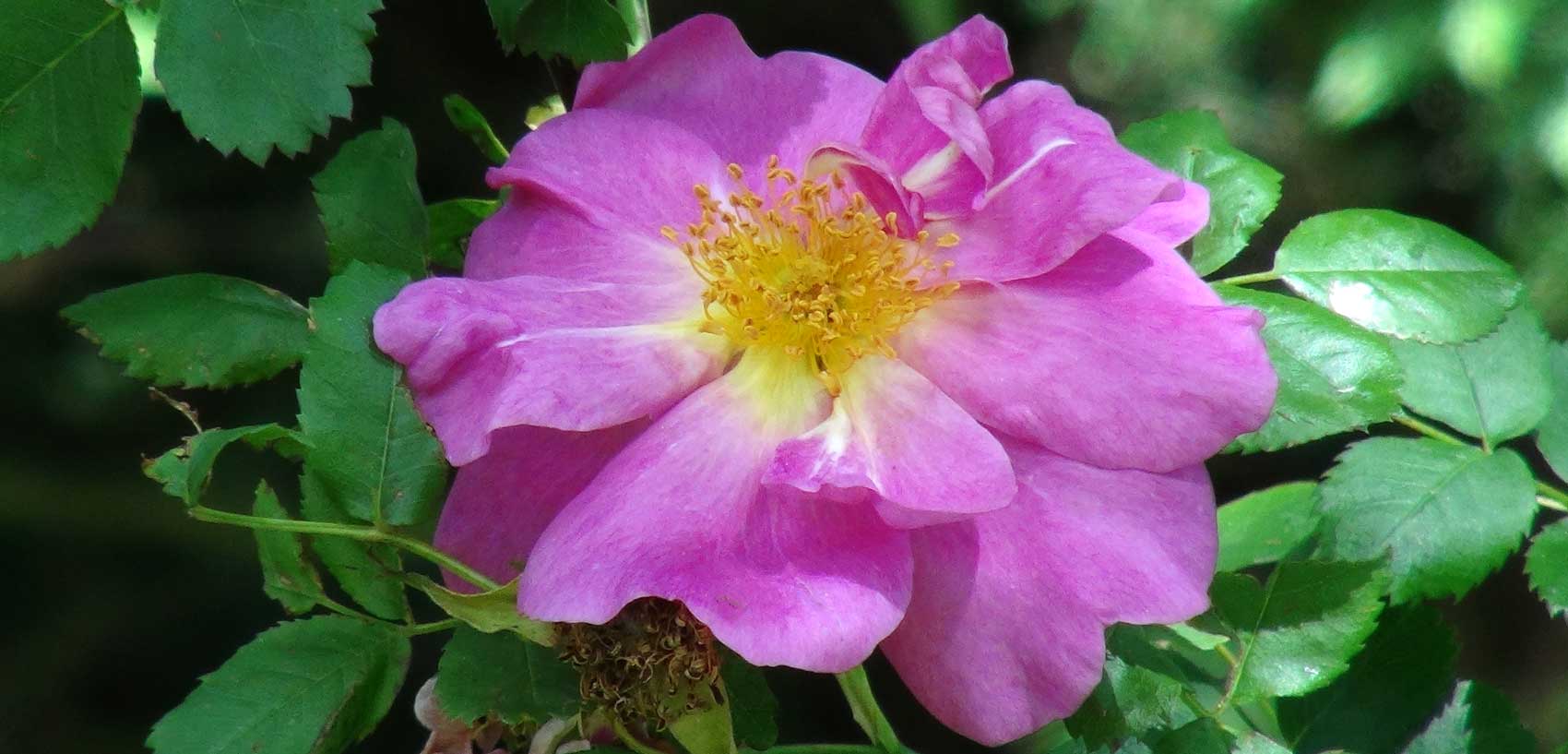 Rosa moyesii
Rosa moyesii• Rosa multiflora (sometimes referred to as Rosa polyantha) comes from regions of China, Korea and Japan and is scrambling by nature, growing up to 4.5m in height while producing large corymbs of small white or pink flowers.
This wild rose has been used to assist in soil conservation, particularly in forming livestock barriers while attracting birds, bees and insects back to degraded areas. But Rosa multiflora’s lasting legacy is from providing rootstock for many grafted ornamental rose cultivars.
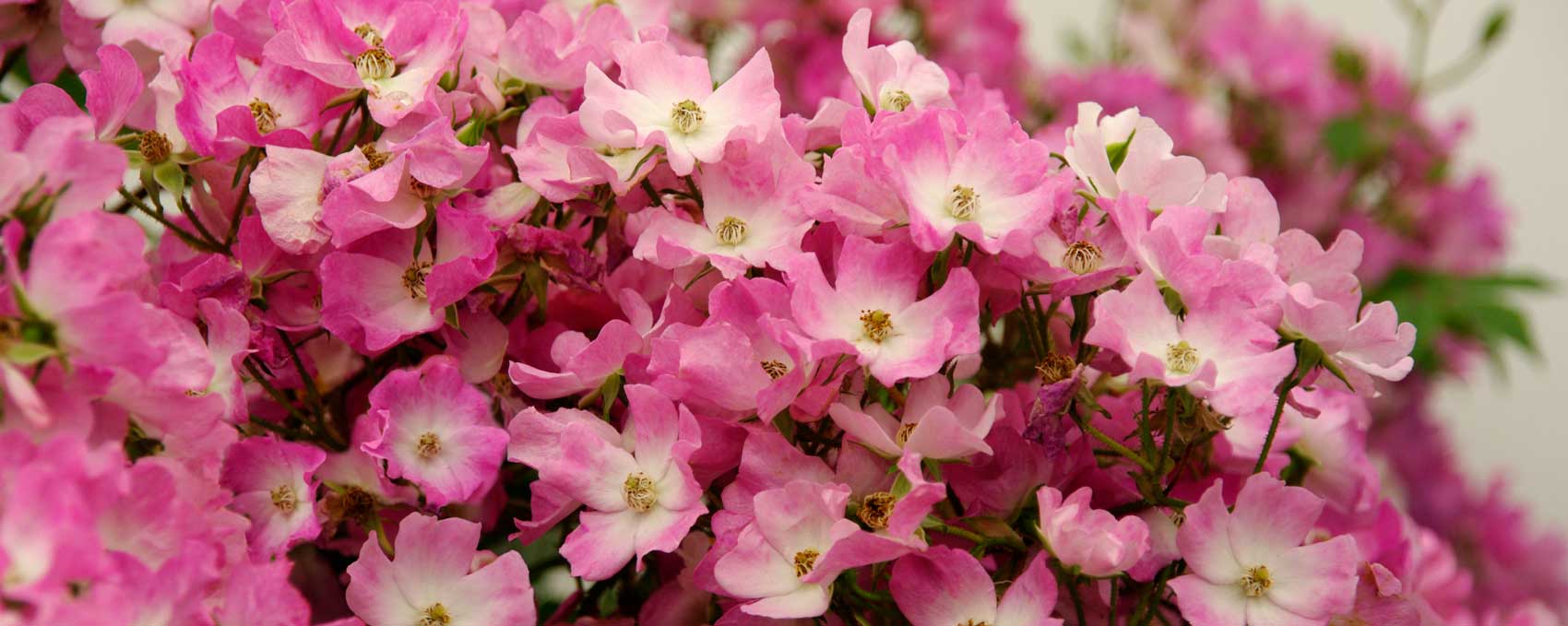 Rosa multiflora - syn. Rosa polyantha
Rosa multiflora - syn. Rosa polyantha• Rosa nitida or the Shining Rose comes from North America is a low growing, suckering rose with attractive glossy foliage that turn to rich autumn colours later in the season. It will grow to around a metre in height at most, with thin stems covered in fine bristles.
The flowers are outstanding being pink and sweetly scented, with a fragrance similar to Lilly of the Valley. This is a hardy rose which can withstand very low temperatures and boggy ground.
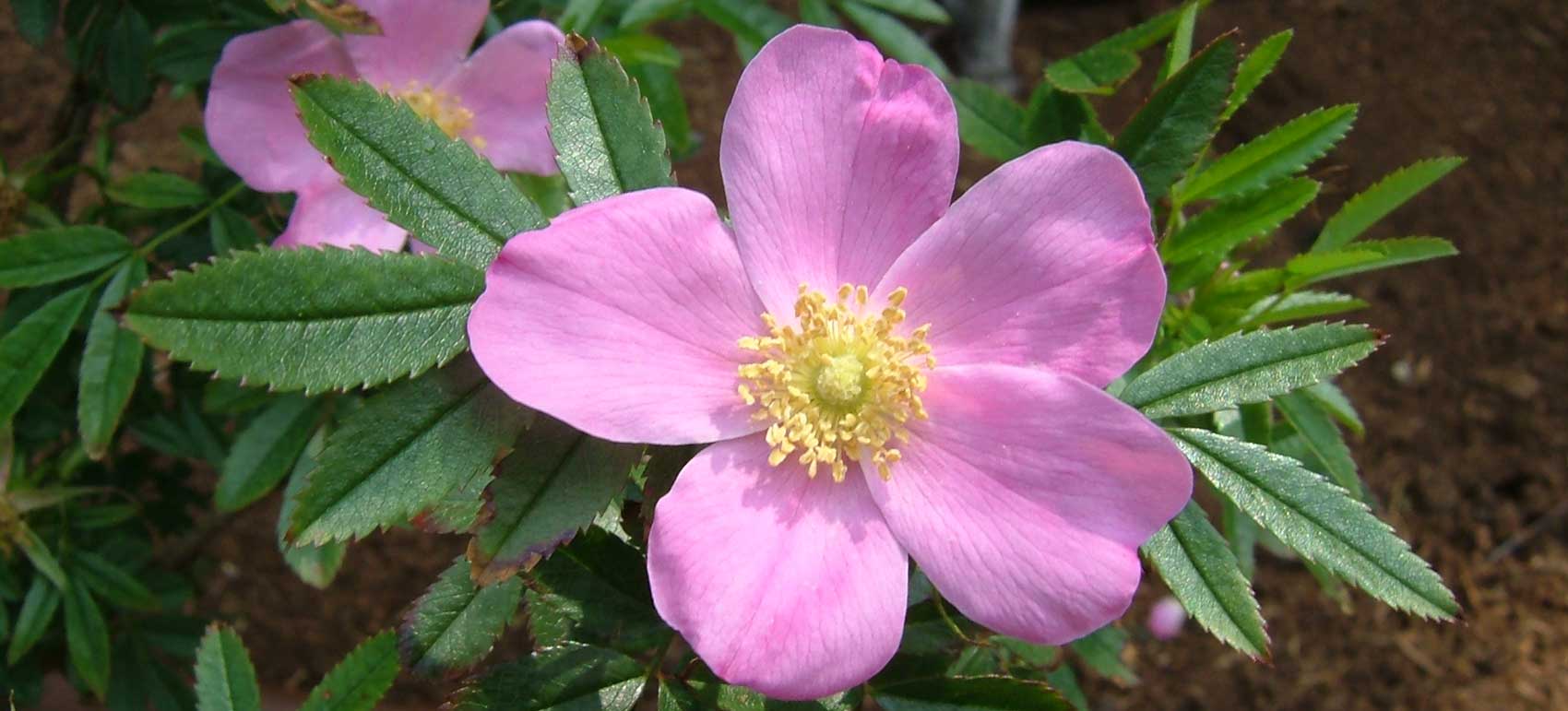 Rosa nitida - photo Sakurai Midori
Rosa nitida - photo Sakurai Midori• Rosa palustris or the Swamp Rose has been found growing naturally in damp or boggy conditions from Nova Scotia in the north down to Florida in the south of North Eastern America. It reaches around 2 metres in height with woody, branching and arched stems at the end of which corymbs of pretty pink flowers are borne.
They bloom for a couple of months in late spring to early summer producing a richly sweet scent, especially fragrant on still evenings.
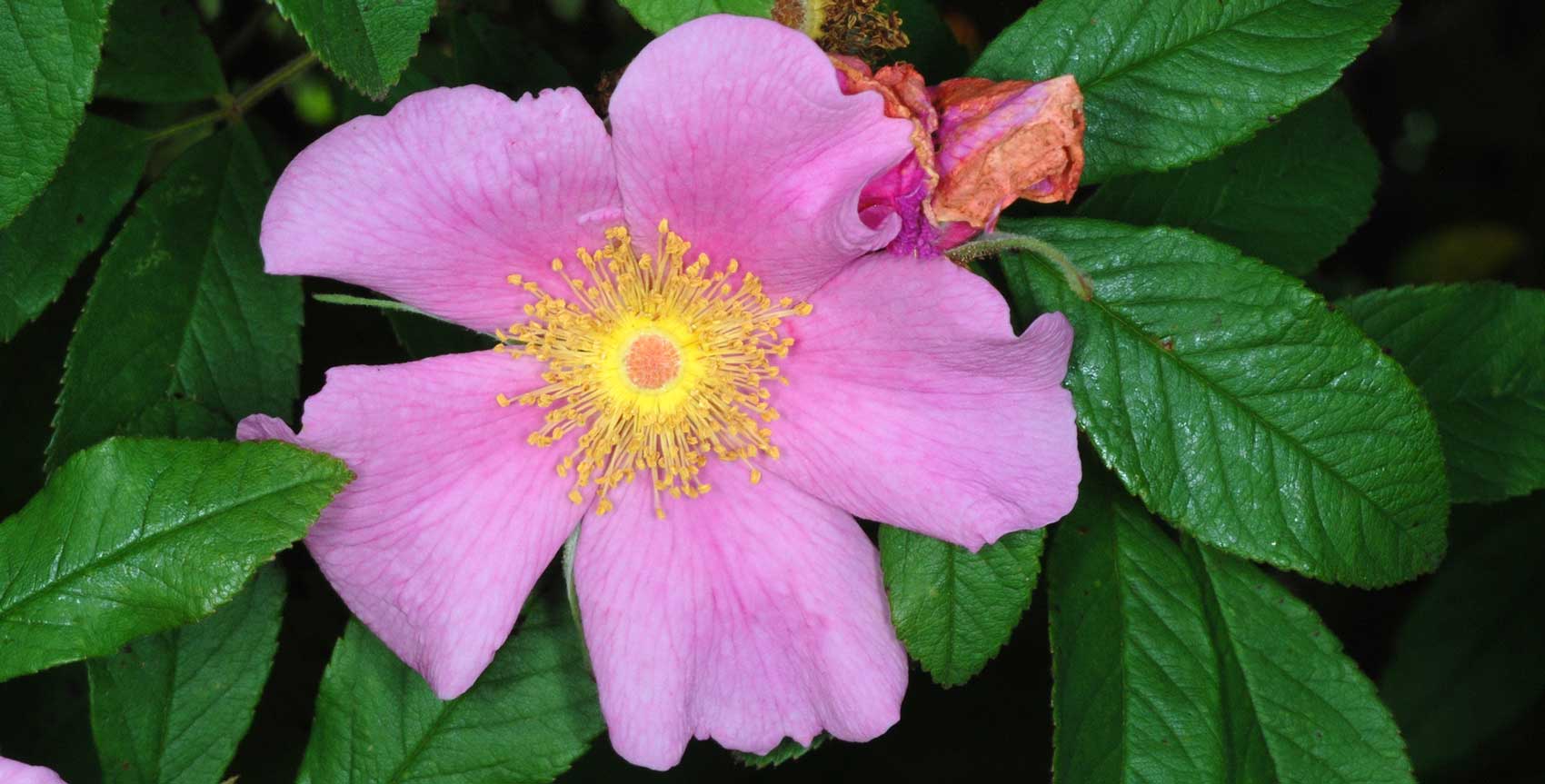 Rosa palustris - photo Douglas Goldman
Rosa palustris - photo Douglas Goldman• Rosa pimpinellifolia or the Scottish or Burnet Rose, is best suited to sand dunes or other poor soils found in coastal areas. It can withstand very cold conditions too, being found as far north as Norway. It rarely grows higher than 1.5m and due to its suckering nature can cover quite large areas.
The stems are finely prickled and strikingly red when young, maturing to a deeper maroon with age.
The pretty five petaled flowers are usually creamy white, though some can be pinkish in colour too. These are followed by currant-like, dark purple, globular hips.
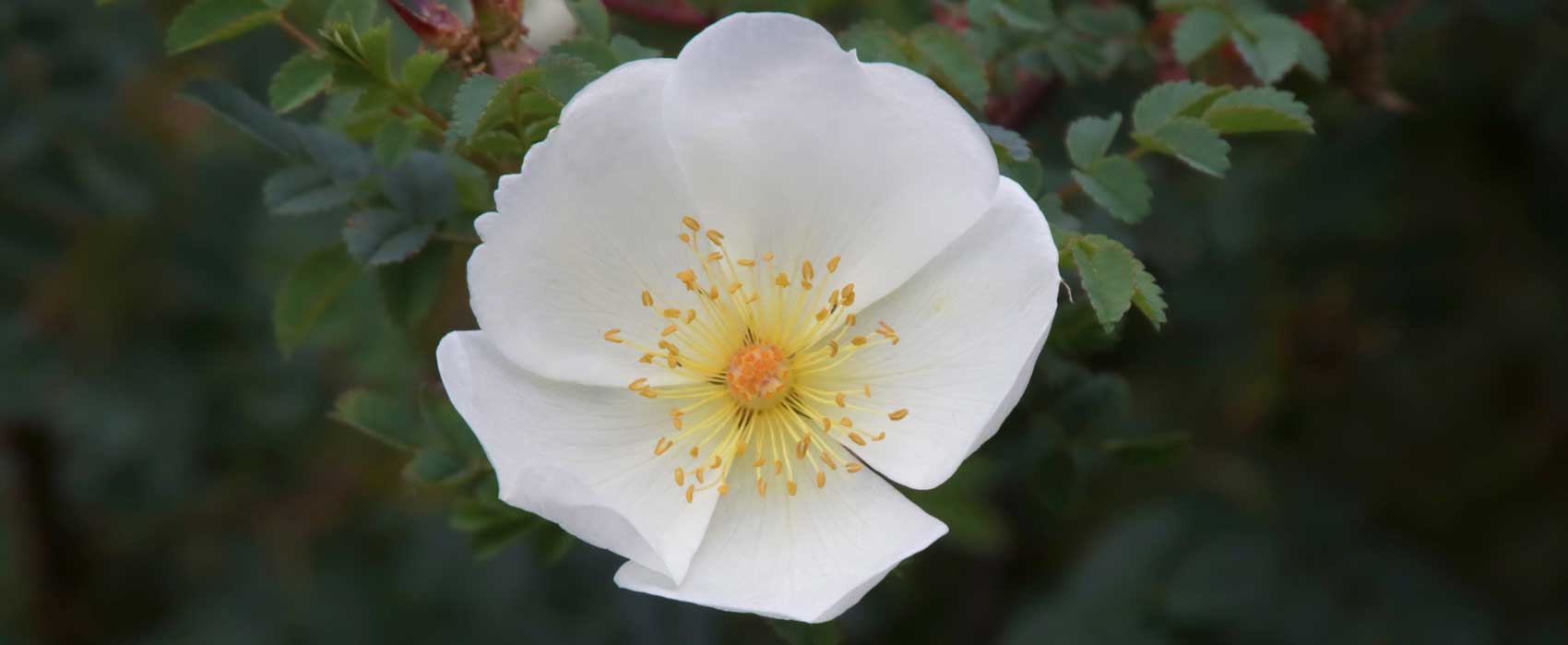 Rosa-pimpenellifolia - The Dunwich Rose
Rosa-pimpenellifolia - The Dunwich Rose• Rosa roxburghii or the Chestnut Rose hails from China and Japan. It is a large, suckering, species rose that produces pretty, flat faced, double, pink blooms which can be quite ruffled in appearance. The blooms have an unusual fragrance for a rose, smelling rather like a ripe pineapple.
It has a multitude of upright, thorny, peeling stems that are silvery brown and pungently aromatic while the foliage is mid green and attractive in it own right.
It makes a good informal specimen in the shrubbery and also goes well as a low hedge. There is good tolerance for heat and humidity too.
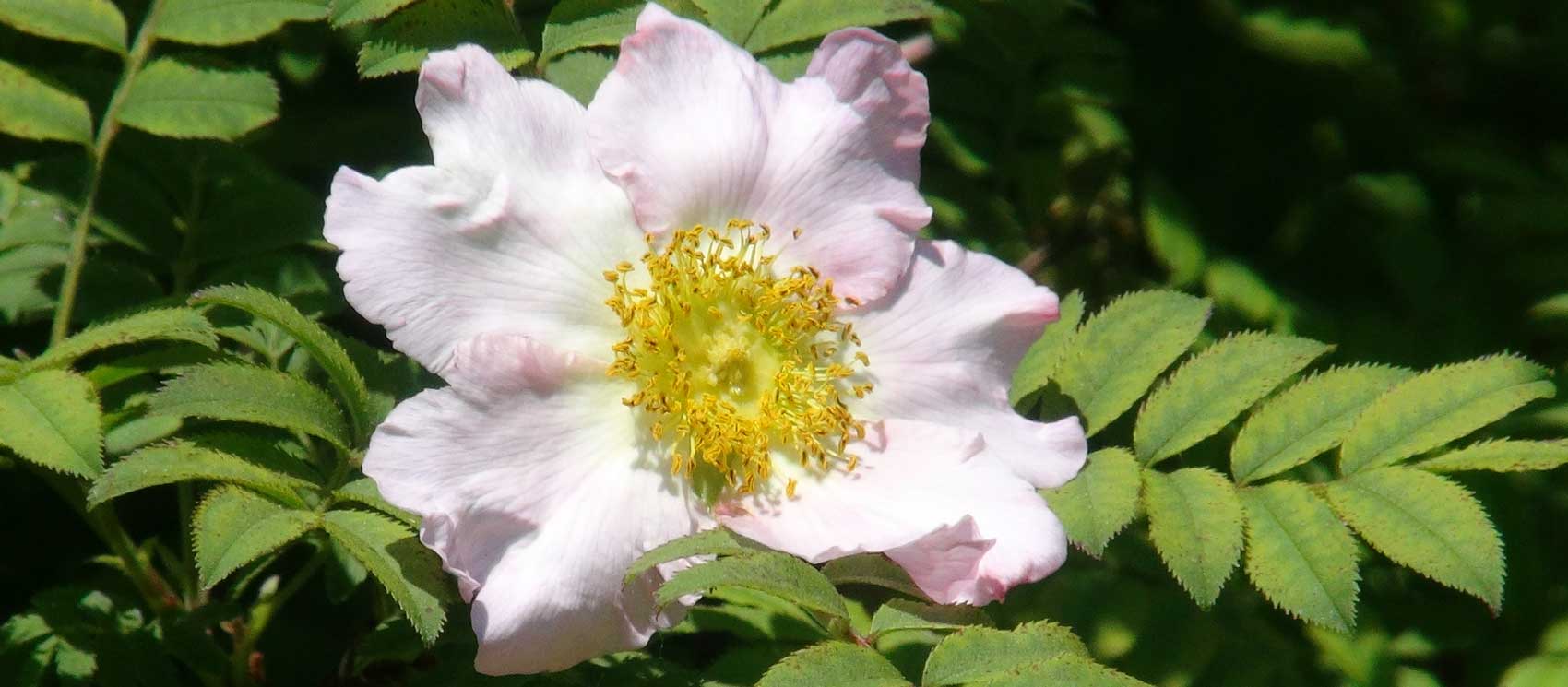 Rosa roxburghii
Rosa roxburghii• Rosa rubiginosa (or rosa eglanteria) from Europe and Western Asia is known as Sweet Briar or Eglantine Rose. It grows to around 2.5m in height and it quite dense in nature, with oval, serrated edged leaves that have a strong apple fragrance.
The flowers are pretty, pink, single blooms with whiter centres and prominent golden yellow stamen. They grow in clusters, appearing from spring through to summer.
Rosa rubignosa is perhaps most famous for rose-hip tea which has been an easy source of vitamin C for centuries. N.B. although one of the prettier roses, it is unfortunately classified as an invasive species in NZ.
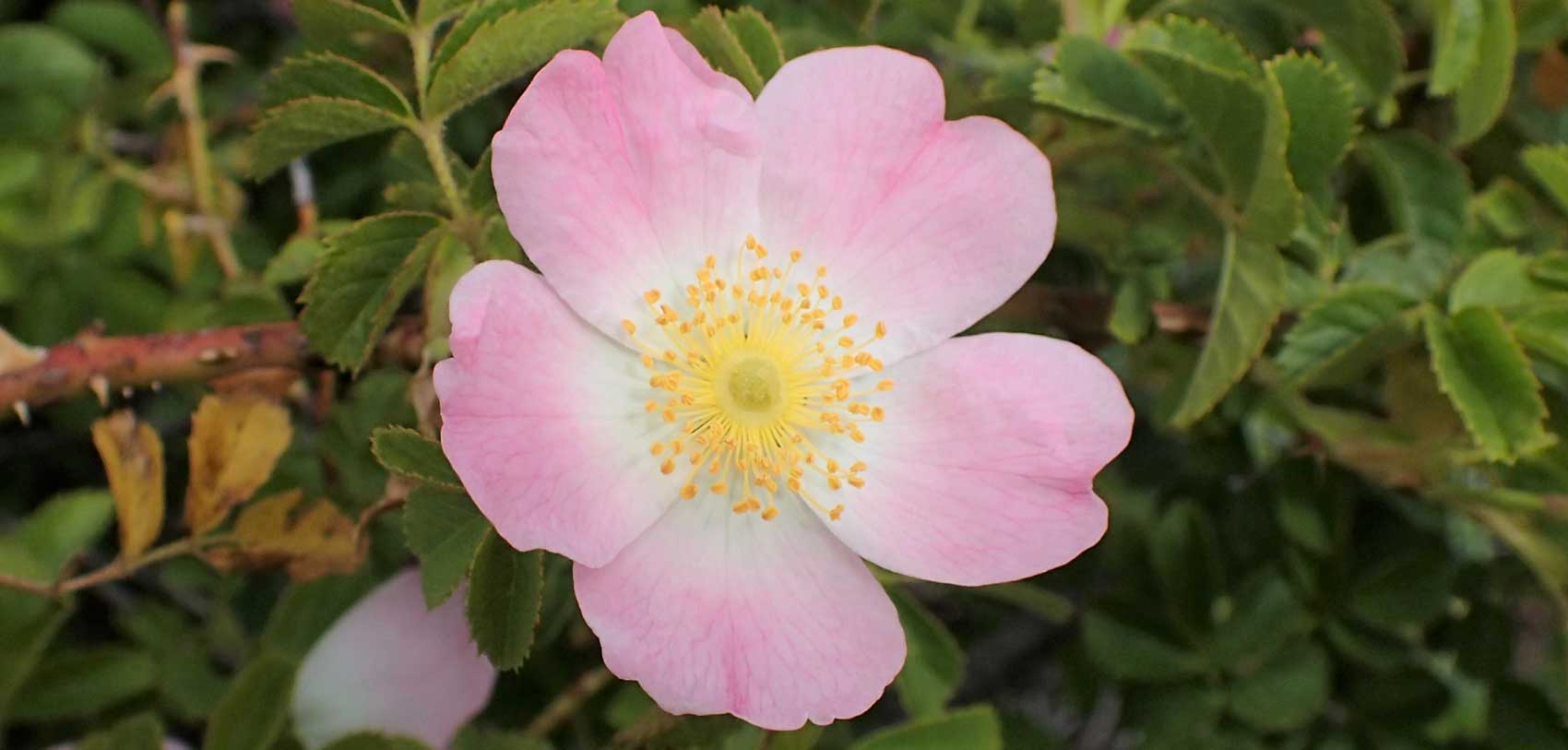 Rosa rubiginosa - photo Krzysztof Ziarnek
Rosa rubiginosa - photo Krzysztof Ziarnek• Rosa rugosa or the Japanese Rose is native to Eastern Asia and has deep green, veined foliage along with rather prickly stems. Throughout summer it can be completely covered with (shades of) pink, pleasantly musky perfumed flowers, followed by large bright red hips that look like cherry tomatoes.
Rosa rugosa are quite hardy and very disease resistant, making good low hedges in difficult climates. They are a suckering shrub, producing new plants from their roots and tend to grow into very dense thickets. Their resistance to salt makes them good for coastal locations and their profuse flowering habit makes for an excellent garden specimen.
Possibly the oldest of all roses it has become a popular breeding rose, providing excellent disease resistance to its progeny. It is also the most popular of the original wild species that is still cultivated today.
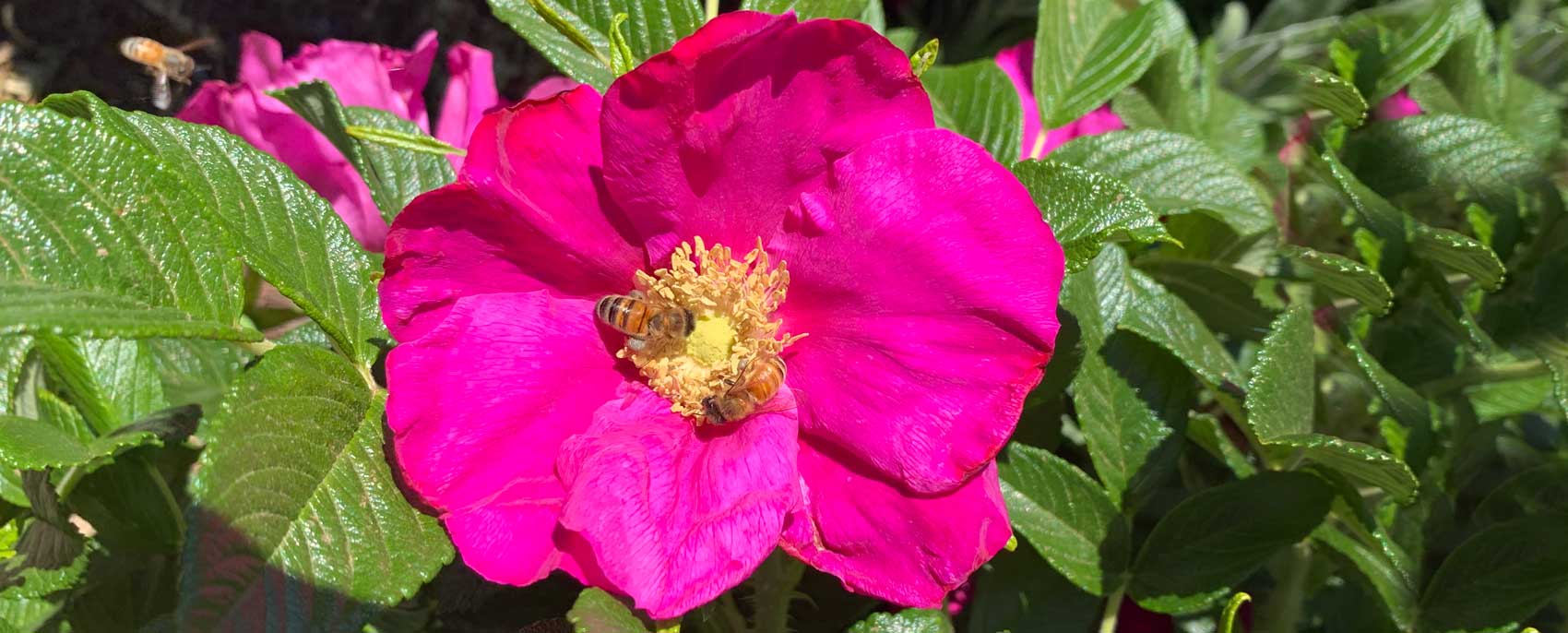 Rosa rugosa
Rosa rugosa• Rosa sempervirens or Evergreen Rose was originally found in Mediterranean parts of Europe and produces corymbs of white, open-faced flowers with hairy styles in spring and early summer. The small orangey red fruits develop in late autumn.
It is a natural climber, reaching up to 5m, providing that it has something to scramble up, and its evergreen nature made it popular for hybridising in middle ages France.
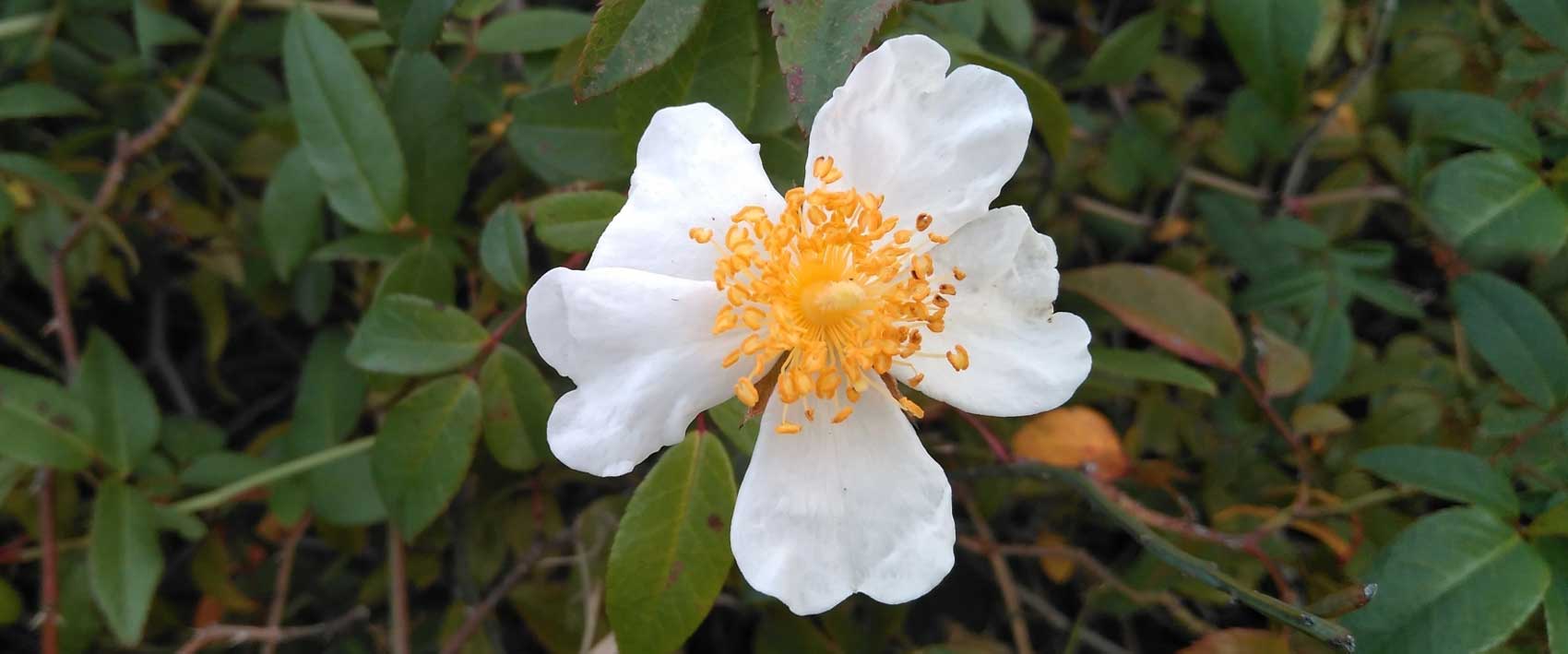 Rosa sempervirens - photo Josep Gesti
Rosa sempervirens - photo Josep Gesti• Rosa sericea or the Silky Rose is another from China and northern India with rather prickly arching stems, fern-like foliage and pretty white flowers in early summer. It grows to around 2metres in height and is the only species rose with four petals (all others having five).
This is one of the more versatile roses being able to grow in most soil types, in sun or shade.
There is a popular variation or subspecies, called Rosa sericea pteracantha which has extraordinarily large, flat ‘Shark-Fin’ thorns. It may sound odd but the striking, red thorns catch the light and add much extra interest at the rear of mixed borders and in flower arrangements.
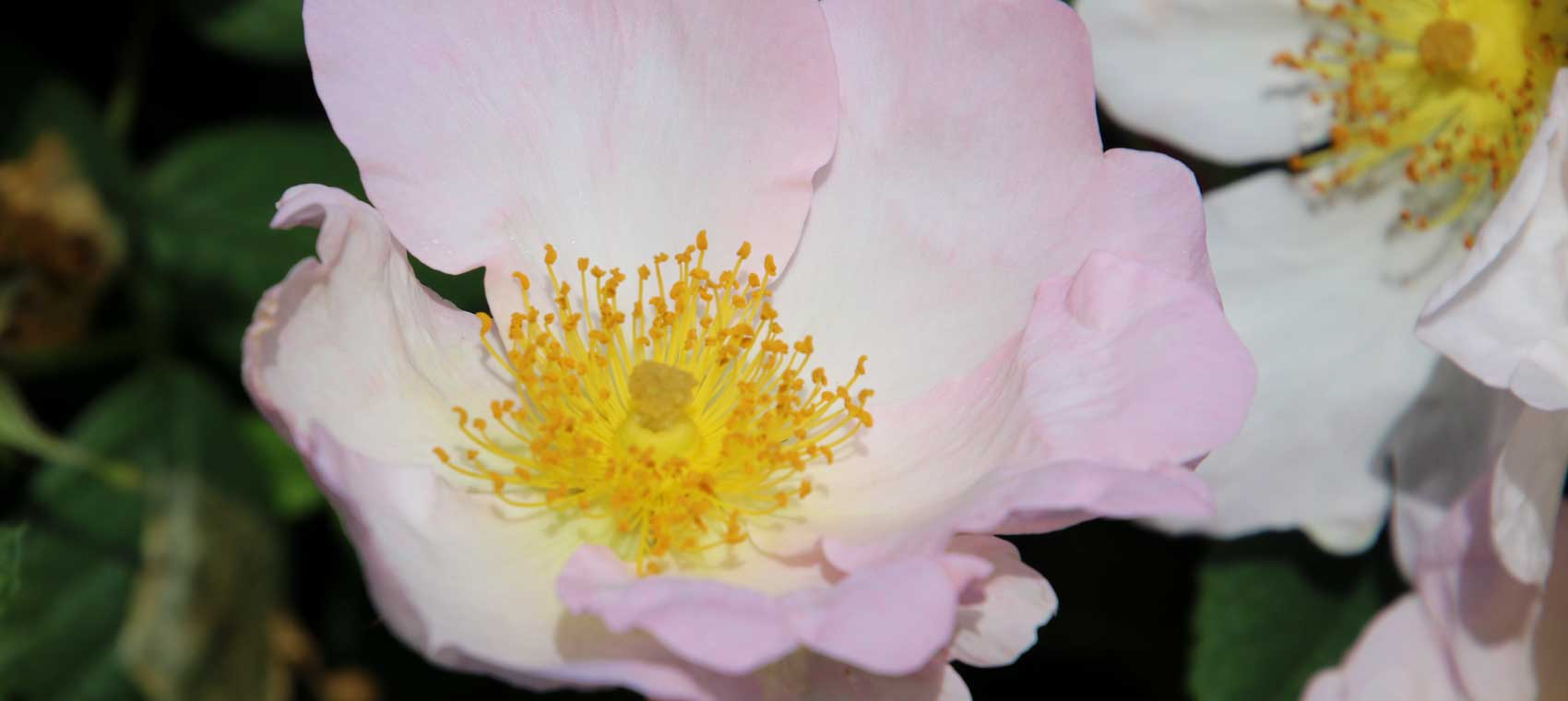 Rosa sericea
Rosa sericea• Rosa setigera otherwise known as the Prairie Rose comes from North America and is of a climbing nature, producing clusters of very fragrant, pink flowers that tend to fade to white as they age. They bloom throughout summer and feature a raised central mound of fluffy golden stamen.
The attractive, dark green foliage turns to rich hues in late autumn and the birds will flock to the showy red rose hips. This is a good rose for larger gardens where there is something for it to grow over like an old fence or trellis where it will grow to 5metres if well supported.
It is very disease resistant. Examples include ‘Baltimore Belle’ and ‘Himmelsauge’.
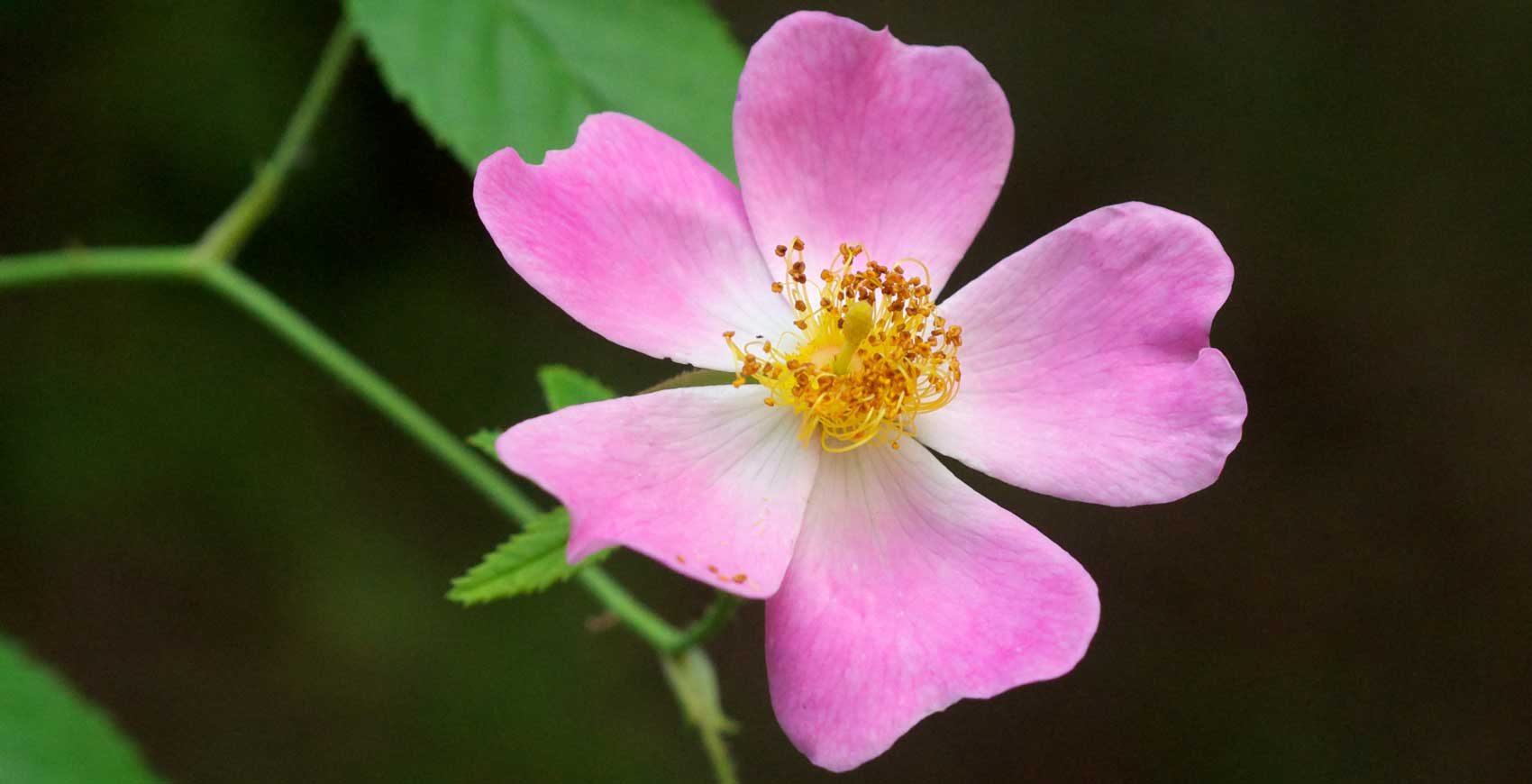 Rosa setigera - photo Eric Hunt
Rosa setigera - photo Eric Hunt• Rosa soulieana comes from China and Tibet grows to three or four metres in height, with beautiful grey/green foliage and trusses of pale yellow to white flowers that feature a large boss of yellow stamen. It has been likened to a sherbet fountain when it is covered so completely in flowers.
This is a rose that really needs plenty of space and then it can be enjoyed to its best. It is outstandingly pretty providing you don’t mind its dominant nature. Examples include ‘Kew Rambler’.
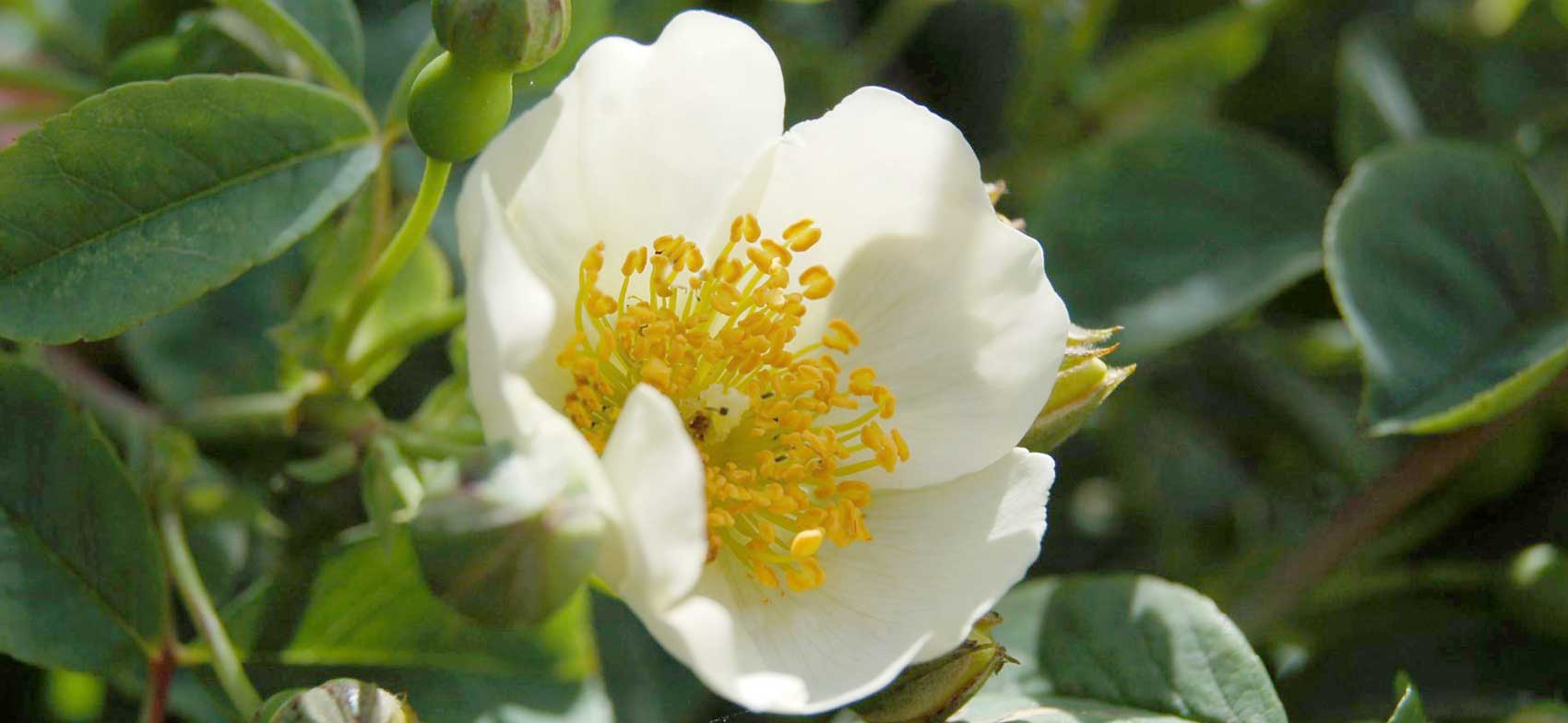 Rosa soulieana
Rosa soulieana• Rosa virginiana or the Virginia Rose originates from North America is a fast growing, compact, deciduous shrub around 1.5 – 2.0m in height with prickly stems, lustrous, dark green, serrated foliage and single, open faced, pretty pink flowers that are delightfully fragrant.
It is particularly notable for its hardiness and ability to grow in dry or saline soils with the blooms lasting over long periods in mid summer.
It is the most commonly cultivated species rose in the USA and has gained the RHS award of merit.
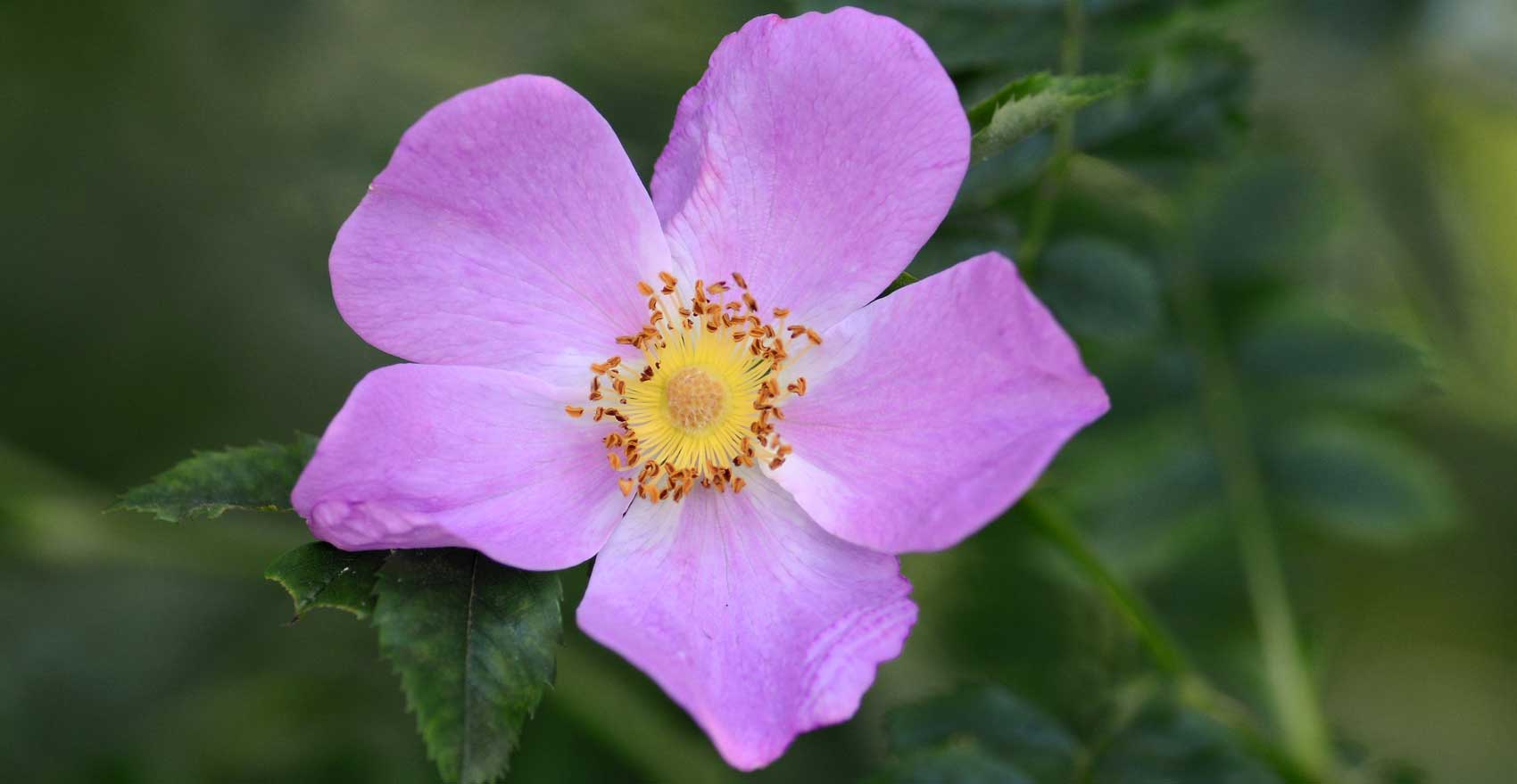 Rosa virginiana - photo Alvesgaspar
Rosa virginiana - photo Alvesgaspar• Rosa woodsii or Woods Rose grows to about 3 metres and has a dense, spreading habit forming deep thickets, though it does produce wonderfully fragrant pink flowers with long and erect golden stamen.
The blooms only last for one day but the rose-hips persist throughout winter providing a good source of food for wildlife.
It is very hardy and can be found as far north as Newfoundland and in the harsh landscapes of the Rocky Mountains. As such it is perfect for cultivation in difficult, dry, steep and rocky locations.
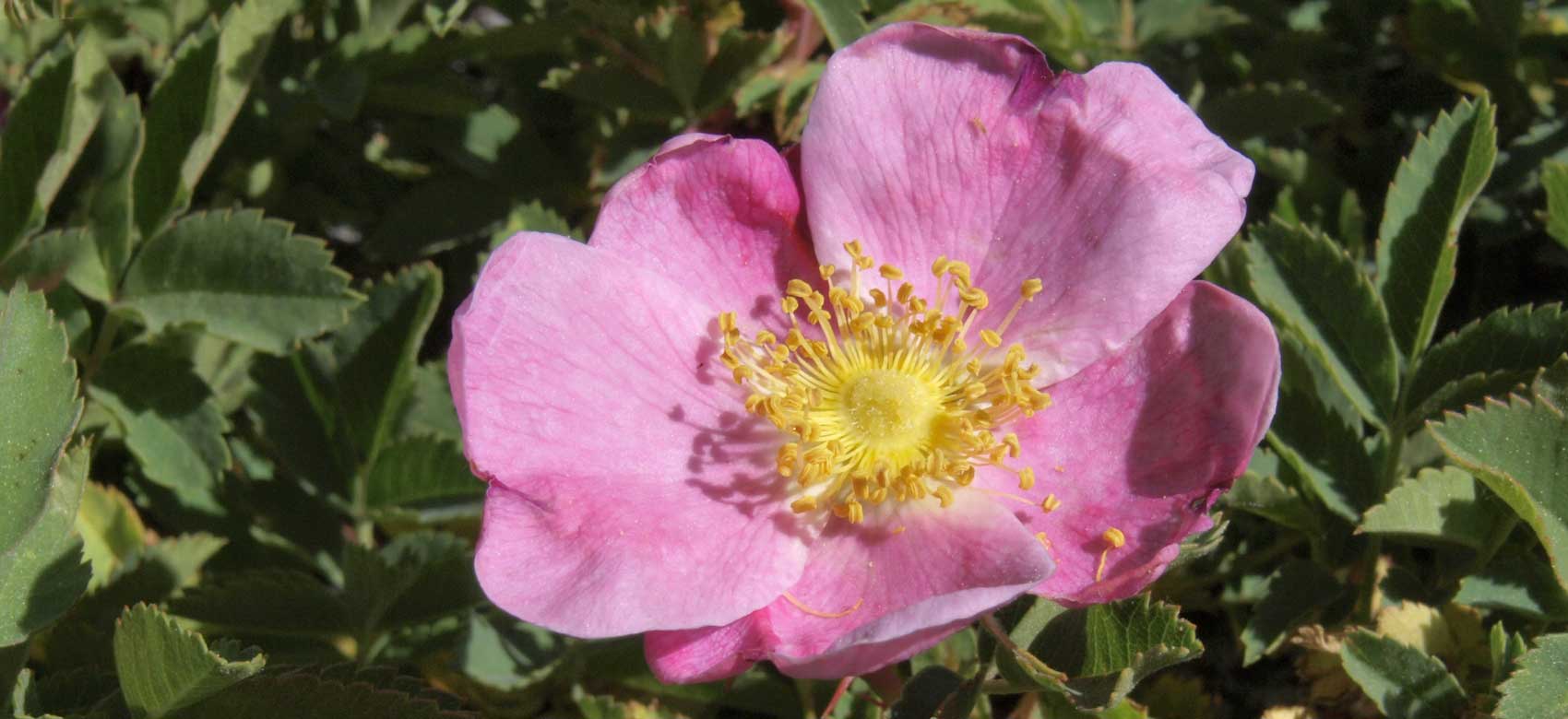 Rosa woodsii - photo Jim Morefield
Rosa woodsii - photo Jim Morefield• Rosa wichurana or the Memorial Rose has long trailing and thorny branches, glossy mid green foliage and single white, open faced flowers with striking yellow stamen but little to no fragrance.
It can reach 6 metres in height with something to support it and makes an excellent barrier or medium sized groundcover.
It is perhaps best known though as a parent of some notable hybrids including ‘Dorothy Perkins’ ‘Alberic Barbier’ and ‘Albertine’.
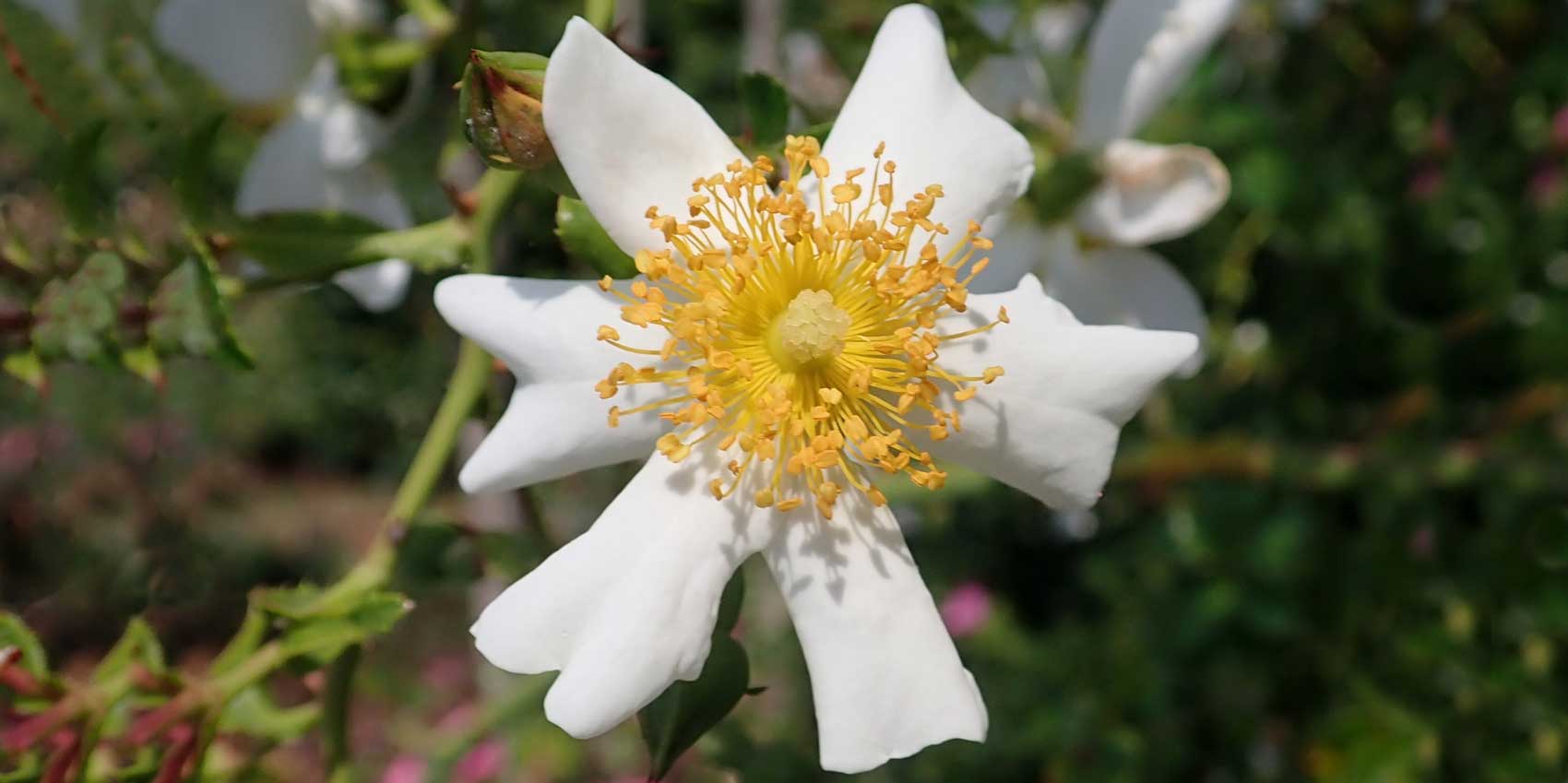 Rosa wichurana
Rosa wichurana• Rosa Xanthina or Rosa hugonis or the Father Hugo Rose comes from China and is very hardy and drought tolerant. It grows vigorously in a vase shape to around 3m, the arching canes and fern-like foliage making for a good backdrop to shrubberies.
It's tough, thorny stems also make it useful as an effective barrier hedge.
Early summer sees flushes of lovely primrose yellow blooms that are particularly attractive to birds, bees and butterflies.
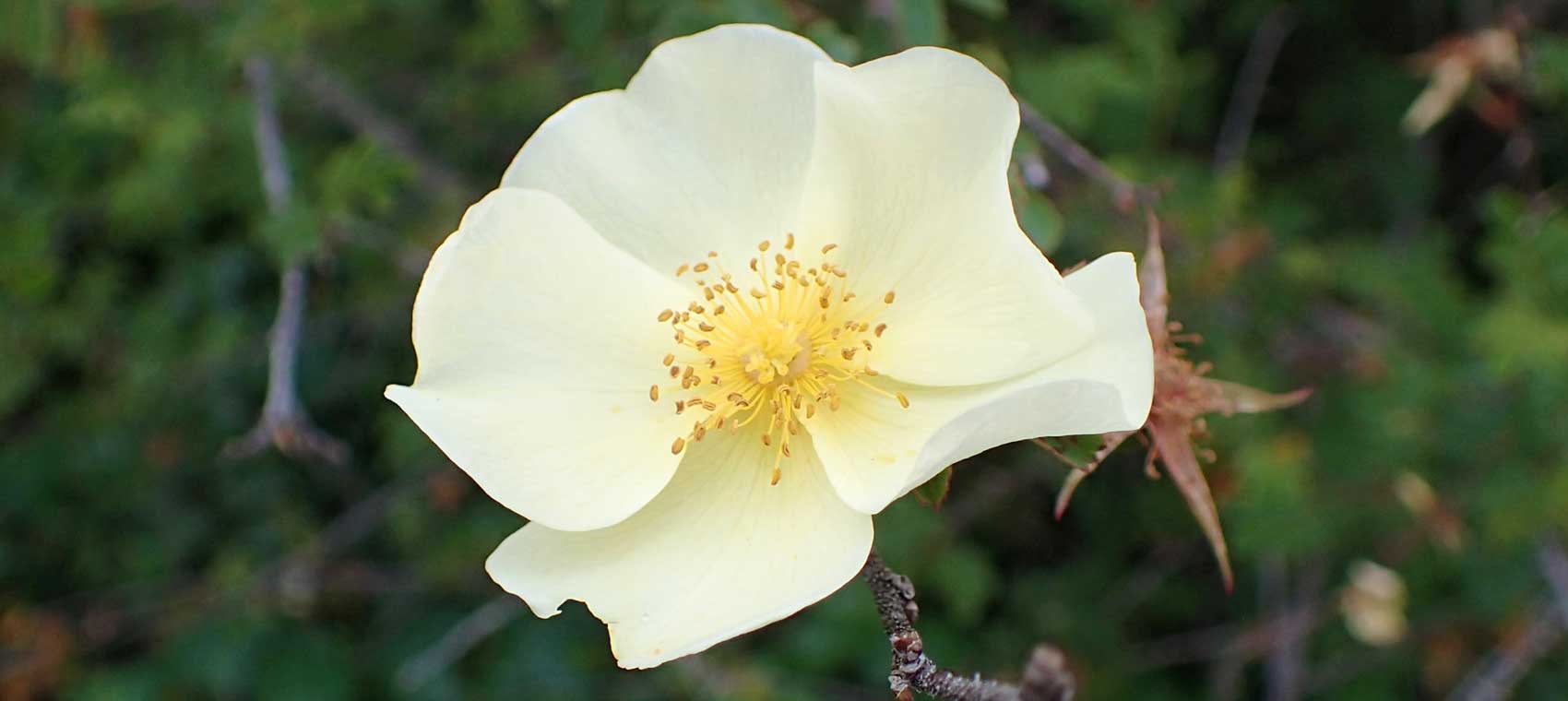 Rosa xanthina syn. rosa hugonis
Rosa xanthina syn. rosa hugonisThese amongst many other species roses have played their part in the creation of the thousands of roses we enjoy in our gardens today.
From Roman times to the 18th century, Europe fell in love with these extraordinary plants. But as affluence allowed, that love affair developed to a besotted passion as breeders created new cultivars to please the burgeoning wealthy classes.
For part #2 of our story of the Rose - click here.